









Lombok International Airport (abbreviated to LIA with the IATA code “LOP”) is the only operating airport on Lombok.
The official name of the airport is Zainuddin Abdul Madjid International Airport, and you will sometimes see “Mataram” or “Praya” on ticketing, but they all refer to Lombok’s airport.
The airport is close to Praya (Central Lombok); approximately 40km south of Mataram City, and around 1 hour drive from Senggigi and 25 minutes from Kuta.
The airport’s terminal is divided into international and domestic sections, with shared arrival and departure areas, and separate boarding lounges. There is no duty-free shopping at the airport but shops and souvenirs, ATMs, and food outlets are easily available.
Airport departure tax is included in the price of all tickets.
Lombok International Airport has full Visa on Arrival (VOA) facilities, including 30 day “Visa Free” (no charge) for tourists. Ph: (+62) 817 1753 5751.
Air Asia operates direct flights between Lombok and Kuala Lumpur, Malaysia every day. Flights are onboard A320 Airbus and flight time is approx. 3 hours. Book cheap flights through the AirAsia website. www.airasia.com
Super Air Jet (a low-cost airline based in Jakarta) also flies between Lombok and Kuala Lumpur every day.
www.superairjet.com
Scoot Airlines (a low-cost subsidiary of Singapore Airlines) flies direct between Lombok and Singapore, four times per week (Tuesday, Thursday, Saturday and Sunday). Flights are onboard A320 Airbus and flight time is approx. 3 hours.
It's also possible to book flights to Lombok with Scoot from Perth, Melbourne or Sydney with an overnight stay in Singapore. Fares are very economical! www.flyscoot.com
Although direct international flights to Lombok are limited at present, international flights to Bali and Jakarta – or to Singapore and Kuala Lumpur – connect Lombok to all major destinations around the world including Europe, the UK, Amsterdam, Thailand and more.
It’s easy to get to Lombok from Bali – flight time is only around 45 minutes. Buy tickets online, or direct from the airline counters at the domestic airports, or contact local travel agents in both Bali and Lombok. In Lombok, all flights depart and arrive at Lombok International Airport. In Bali, flights arrive and depart at the domestic terminal at Ngurah Rai (Denpasar) Airport.
Citilink has two direct flights between Lombok and Bali every day with a free 10kg baggage allowance. www.citilink.co.id
Wings Air / Lion Air flies between Bali and Lombok up to four times daily. The companies code-share, so you purchase tickets through the Lion Air website for a Wings Air flight. Note: tickets include no luggage allowance; book pre-paid baggage through their website. www.lionair.co.id
European connections are easy via Jakarta (the capital city of Java), Bali and other capital cities such as Jogjakarta and Surabaya. Direct flights to Lombok from Bali, Jakarta, Jogjakarta and Surabaya are available from multiple airlines every day and are usually timed to connect with European flights.
Air Asia operates direct flights between Lombok and Surabaya every day. www.airasia.com
Batik Air flies direct between Lombok and Jakarta every day. www.batikair.com
Citilink has direct flights between Lombok and Jakarta, and Lombok and Surabaya, three times a week. www.citilink.co.id
Garuda Indonesia has direct flights daily between Lombok and Jakarta. www.garuda-indonesia.com
Lion Air / Wings Air has daily flights between Lombok and Bali, Jakarta, Jogjakarta, Surabaya, Sumbawa Besar and Bima (Sumbawa). www.lionair.co.id
Super Air Jet flies between Lombok and Jakarta, Jogjakarta, and Surabaya every day. www.superairjet.com
Padang Bai Harbour (east Bali) provides the sea link between mainland Bali and Lombok. Lembar Harbour (Lombok) is on the southwest coast, approx. 1 hour from both Senggigi and Kuta.
Arrange transport and buy tickets direct from the ticket office at the harbours, or use a reputable tour company to provide a transfer service.
Public Ferries run 24 hours a day and depart every hour for the sea crossing between Bali and Lombok. The fare is Rp 62,200 per person and the trip takes approx. 4 to 5 hours, depending on sea conditions.
It’s a slow but scenic ferry trip and the cheapest way to travel between the islands. It’s also useful if you want to take a motorcycle (approx. Rp 160,000) or small car (approx. Rp 1,127,000).
There are numerous fast boat services operating between Bali and Lombok every day, via the Gili Islands. All fast boats must stop at Bangsal Harbour in North Lombok for port clearance, so it is possible to reach mainland Lombok using any of the fast boat services to the Gilis. See our Gili Guide for more.
Gili Getaway operates several comfortable fast boats connecting Bali and mainland Lombok (including Gili Gede in southwest Lombok) from Serangan Harbour on Bali. www.giligetaway.com
Eka Jaya offers fast boat connections between Bali (Padang Bai Harbour) and Senggigi (West Lombok). Boats arrive and depart from the Senggigi Jetty, right in the centre of Senggigi Beach.
www.ekajayafastboat.com



Dear Readers
April is a beautiful month in Lombok! With the worst of the monsoon season over, the days are cool and sunny, and the island is lush and green from the recent rains.
It’s that perfect ‘in-between time’ when there are no crowds and prices are still low, waterfalls and rivers are full, and outdoor adventures are at their best.
It’s also the perfect time for trekking Lombok’s famous volcano – Mt Rinjani! And with the annual trekking season now open, it’s a great time to beat the crowds that will be arriving in July and August peak season.
On 10 April, Indonesia’s fasting month comes to an end and everyone will be celebrating Idul Fitri or Lebaran… it’s an incredibly happy time to be on Lombok. Read our special feature on page 30 and remember to plan your travel around the upcoming Idul Fitri holidays, which total ten days this year (including two weekends).
For those living on the island, note that banks, government offices (including immigration, if you need visa renewals or exit permits) and many other businesses will be closed from Saturday, 6 April until Tuesday, 16 April.
Whether you are a first-time visitor to Lombok or a seasoned traveller returning for the tenth time, The Lombok Guide is committed to provide you with the information you need – attractions and activities, places to visit and things to see –all brought together in one convenient Guide.
The island awaits… welcome to the magic of Lombok!
Page 2 Getting to Lombok
Page 4
Contents
Page 6 Lombok Map
Page 8 & 10
Getting Around
Page 12 & 13 Best in Lombok
Page 14 Senggigi Map
Page 16 & 18 Senggigi & The West Coast
Page 20 Hot in the Bok!
Page 26 Seven Secrets (This tittle secret is out!)
Page 30 & 31 Idul Fitri... A Nation Celebrates!
Page 32 Distribution
Page 34 & 35 Rinjani Trekking Season Open!
Page 40 Pasar Classified
Page 42 The Cities Map
Page 44 & 48 The Cities
Page 50
Useful Contacts
Page 51 - 57 Kuta & The South Coast
Page 58 Kuta Map
Page 59
South Lombok Map
Page 60 - 63 The Southwest
Page 2 & 4
Getting to the Gilis
Page 6 The Gilis Map
Page 8 - 15 The Gilis, Lombok's Three Iconic Islands
Page 16 Gili Islands Fast Facts
Page 18 & 20
Page 21
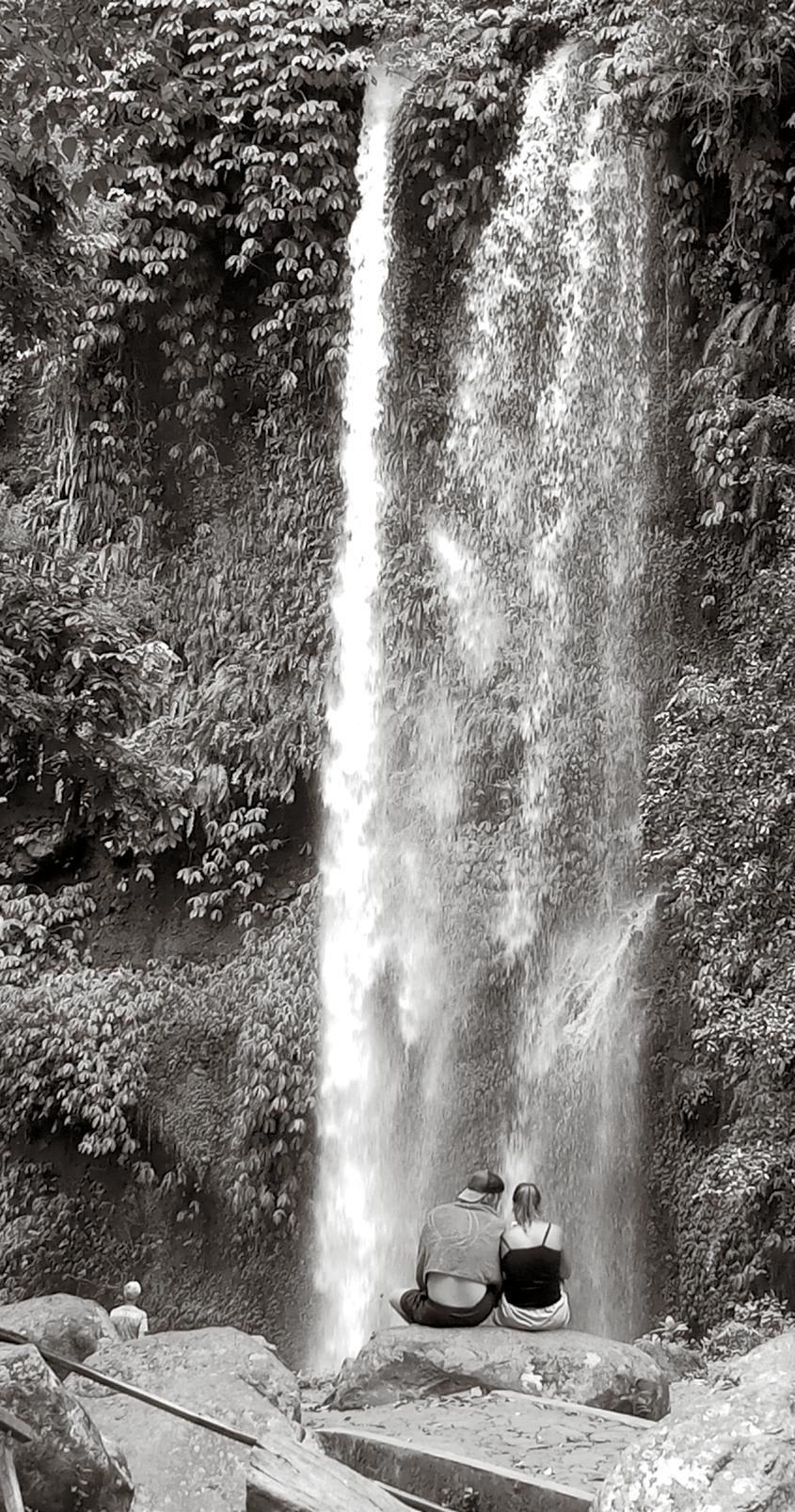


Best in the Gilis
Planning Your Gili Getaway
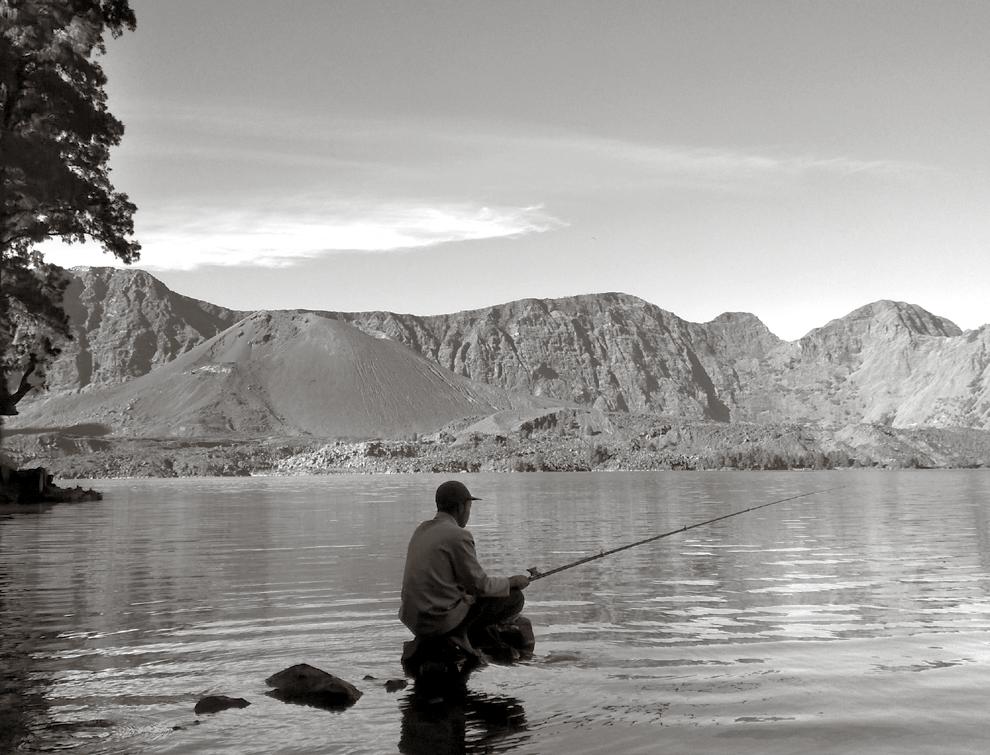

5-star Luxury in Southwest Lombok

Escape to the tranquility of Gili Gede - Gateway to the Southwest Gilis
Stay in luxurious one- and two-bedroom air conditioned villas with private swimming pools or an absolute beachfront bungalow.
Enjoy all day dining at our romantic beachfront restaurant and bar.
Activities include:
• Pure poolside relaxation • Healing Sasak massages
• A round of tennis, workout in the gym, or choice of water sports
• Island hopping including a secluded island picnic
Get there fast, then take it slow... with easy fast boat transfers from Bali, Gili Trawangan and Lombok direct to our private jetty



www.kokomogiligede.com

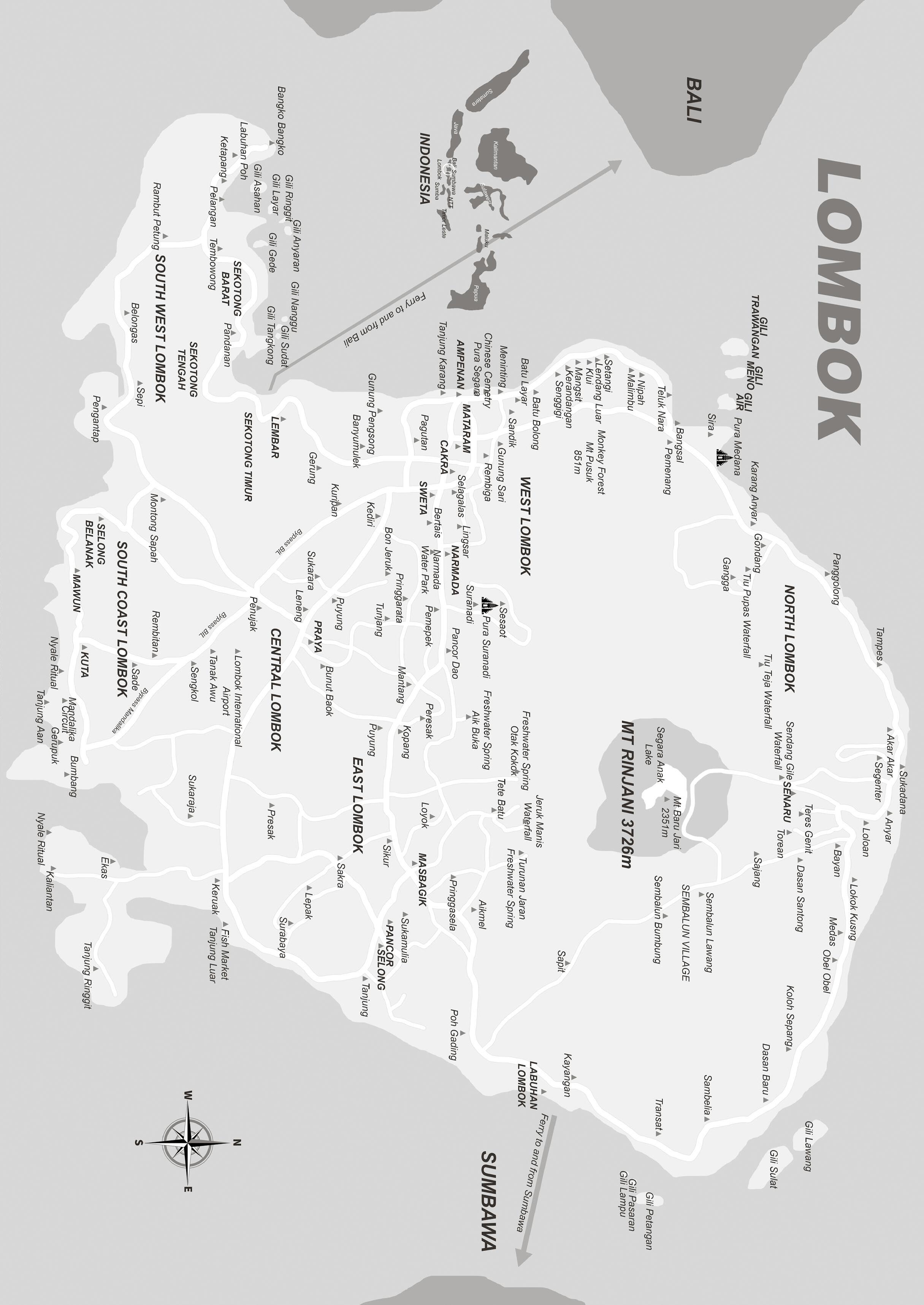




is a relatively small airport that handles domestic flights between Bali, Jakarta and other Indonesian cities, and international flights to and from Singapore and Kuala Lumpur.
Getting to the Airport: Lombok Taxi (Blue Bird) is the most convenient taxi operator throughout Lombok and will drop passengers directly in front of the departure terminal. Note: Lombok Taxi (Bluebird) cannot pick up passengers from inside the airport grounds.
Otherwise, book an airport transfer through your hotel or a private car and driver service. There is ample parking at the airport and cars can be left overnight.
From the Airport: taxis and private cars are available to meet all arriving flights. After collecting your baggage, head out of the exit doors of the terminal and through to the arrival hall.
There are official taxi counters inside the arrival hall that will allocate you a fixed

price taxi to most destinations. Prices can be negotiated.
Golden Bird Taxi is the premium branch of Blue Bird Taxi and offers regular taxis, limousine and car rental. Look for their desk in the arrival hall or WA 0859 5462 7000.
There are also many private drivers waiting to offer rides to anywhere on the island. This is a good option if you are in a group or have a lot of luggage or sports equipment, such as surf boards. Negotiate a fixed price before you get in the vehicle.
Organising an airport transfer with your hotel is often the easiest option, with the hotel driver meeting you on arrival and transferring you to your hotel in airconditioned comfort. Check with your hotel – charges are usually only slightly more than a taxi.
Approximate taxi fares: Kuta Rp 150k; Selong Belanak Rp 250k; Sekotong Rp 400k; Senggigi Rp 250k; Mataram Rp 150k; Bangsal Harbour Rp 350k; Senaru Rp 500k.

Car rental kiosks are located at the arrival terminal and are open from 7am until 10pm daily.
For low-cost airport transfers, the public DAMRI bus is the cheapest way to travel between the airport and Senggigi and Mataram.
The air-conditioned buses seat around 40 passengers and operate a regular schedule of departures from 7am to 5pm every day. Buses to Mataram leave every hour and cost Rp 25,000. Buses to Senggigi leave every 90 minutes and cost Rp 35,000.
The DAMRI counter is located inside the arrival hall and prices are clearly shown on sign board at the counter. The bus parks just outside the hall on the right.
The helpful drivers tend to stop at popular points along the route. If you need to stop at a certain point, let the driver know and he will usually accommodate your request.
Continued on Page 10








Continued from Page 8
Around Lombok: Lombok is easy to get around. The roads are in good condition and there is little traffic, apart from in the cities.
The island itself is only slightly smaller than Bali at 115km (70 miles) long and 80km (50 miles) wide; however, it is not practical to drive around Lombok in one day.
Taxis are easily available in most areas on Lombok apart from Kuta, Lombok. Unlike in other areas of Asia, all taxis use their meters (argo) to calculate fares, so there is no need to haggle a price.
Lombok Taxi (operated by Blue Bird Taxi, light blue colour) is the largest company in Lombok and you will find them in the cities and around tourist areas such as Senggigi. Express Taksi (white cars) are also available, mainly in the cities.
Taxis can be used to make trips to Kuta or Lembar and Bangsal Harbours and, if you are shopping or making day trips by taxi, ask the driver to wait and leave the meter running. Fares are still very low compared to those in the west. Short trips around Senggigi will cost around Rp 30,000; a taxi from Senggigi to Mataram is around Rp 80,000.
Phone for a taxi or ask your hotel to phone, or flag one down from the side of the road. Make sure the driver starts the meter when you get in.
Download the “My Blue Bird” app to book taxis easily. The app is also handy for calculating distances and fares when planning trips and the fare will give you a general idea of the rate you should be negotiating with a private driver.
Lombok Taxi (Blue Bird), ph: 0370 627 000 (or download the ‘My Blue Bird’ App from Play Store, App Store or from the Blue Bird Group website). www.bluebirdgroup.com
Gojek and Grab also operate in most areas of Lombok (apart from Kuta on the south coast). Download the apps for easy transport options via car or motorbike. Note that taxis can drop off guests in Kuta but cannot pick up from Kuta. If you are staying in Kuta, the best options are to ride a motorbike or hire a car and driver.
Cars and Motorbikes can be hired in Lombok and driving yourself is easy. Cars drive on the left-hand side of the road (as in the UK).
Car hire can be arranged at the airport and car rental companies in Mataram. However, self-drive car hire isn’t popular in Lombok and most will include a driver. Modern, air-conditioned cars that comfortably seat
4 - 5 people with a driver can be hired for between Rp 600 - 700,000 per day, including petrol and basic insurance.
A private car and driver can be arranged in all the tourism areas, either through your hotel or from talking to the drivers that hang around on the streets looking for customers.
Negotiate a price and what is included in the rate (petrol, duration of hire, waiting time, entrance fees if you are visiting attractions, etc). It’s easy to arrange transport this way, whether for a short trip to a restaurant or a full day of exploring.
Motorbikes are the most popular form of transport and are generally small, light 110 - 125cc motorbikes with automatic transmission. Modern and economical scooters, such as a Honda Vario, are easy to ride. Expect to pay between Rp 60 - 75,000 per day for motorbike rental, depending on age and type. Both require an international drivers’ licence.

Do wear a helmet and appropriate shoes when riding a motorbike and don’t decide that Lombok is the place to learn to ride! Apart from the dangers from other riders and a general disregard for road rules, there can be unexpected hazards such as dogs, chickens, cows and children running into the road.
Tours are readily available in all the tourist areas, and drivers and guides are licensed by the local Kotasi (tour organisation), who also regulate prices in the industry.
Most tour operators are reliable and will have a wealth of local knowledge, which can make touring a more rewarding experience. It is also the most comfortable way to explore the island, as you have time to sit back and observe, rather than negotiating traffic and unfamiliar roads.
Popular tours, such as day trips to waterfalls or traditional villages, are structured to take in a full day of sightseeing with stops at other points
of interest along the way. Tours range between Rp 350 -700,000 a day for a driver and an air-conditioned vehicle for up to 4 passengers, depending on distances and the number of places visited.
* Prices are approximate. Expect to pay higher prices during peak seasons.
Useful Tip: WhatsApp is the most popular messaging service in Indonesia. Download the app to your phone for convenient messaging and phone calls to Lombok businesses wherever there is internet available.
Luggage Storage in Bali: If you’re travelling with too much baggage or extra equipment such as surfboards, you can take advantage of a great offer from Bali Wake Park in Benoa, just 5 minutes from the airport. Spend some time trying out their fun range of water sports or simply have a drink and a meal before or after your trip to Lombok and the Park will give you free storage facilities until you return. If you have a late flight, you can spend the afternoon swimming and have a cold beer before you head to the airport. See advert on The Gili Guide Page 17.



Lombok is a world-renown surfing heaven amongst surf enthusiasts and, more than any other island in Indonesia, Lombok offers year-round surf, with peak months between April and October.
Kuta, on the south coast, is surf-central and has a range of accommodations and facilities especially for surfers. Here you can hire a board, get board repairs and take surf lessons from the professionals. To take your surfing experience to the next level and join one of the many surf camps and retreats available year-round.
Beginners and intermediate surfers should head to the steady, consistent waves found
in the south at Selong Belanak. There are a number of places on the beach that hire boards by the hour and surf coaches patiently instruct beginners on the art of surfing.
The waves at Gerupuk and Tanjung Aan offer a variety of challenges from beginners to sheer madness! Tanjung Aan has consistent surf all year round, while Gerupuk has five surf breaks with something for all levels.
Ekas Bay has two surf breaks: Inside Ekas and Outside Ekas with waves suitable for beginners to experts, depending on the season.
West from Kuta, you’ll find surf at Mawi, Are Guling, Tampah and more. Make friends with the locals to find more hidden surfing gems!
Huge waves and challenging surf lure die-hards to Bangko-Bangko (also known as Desert Point) on the south-western tip of Lombok. Only for the experienced and brave, Desert Point is regarded as one of the best waves in the world!
At certain times of the year when conditions are right, you’ll also find locals surfing the breaks at Senggigi and Mangsit Beach, and off Gili Air and Gili Trawangan. Lombok is an island that loves to surf!



Hate crowds and want to kick back on peaceful beaches, exploring uninhabited islands and uncrowded reefs? If so, the southwest coast is for you!
Thirteen magical islands sit just offshore waiting to be discovered by those who love the water and the beauty of nature. Most are uninhabited but you’ll find excellent accommodation options on Gili Gede and Gili Asahan.
Spend your days lazing in the sun, taking walks along the beaches, fishing, kayaking, island hopping and swimming.
Diving and snorkelling enthusiasts will be in their element with 19 pristine reefs covered in vibrant and healthy coral and teeming with marine life to explore. Spot elusive lion fish, sea horses and majestic turtles, in addition to all the other tropical species that live on the reefs here.
Base yourself on the big island of Gili Gede and spend your days exploring the nearby islands of Gili Layar, Gili Ringgit, Gili Asahan, tiny Gili Goleng and more.
Undeveloped doesn’t have to mean basic (although you’ll find accommodation
to suit all budgets on Gili Gede and Gili Asahan). Combine your Robinson Crusoe experience with luxury and style at Villa Selalu or ko-ko-mo Resort, Gili Gede, or barefoot chic and the best diving at The High Dive, Gili Gede.
Much of the island is still covered by natural rain forest and jungles, making Lombok ideal for ecotourism and trekking tours.
There are a number of areas on the island which provide lovely trekking
opportunities, whether travelling independently or as part of a tour.
Rinjani National Park covers 41,330 hectares and sits inside a major biogeographical transition zone (Wallacea). This zone, known as the “Wallace Line”, marks the transition point where the tropical flora and fauna of South East Asia meets that of Australasia.
Trekking in the Park can be organised from the villages of Teres Genit, Bayan and Senaru in the north. Treks often include walks through rice terraces and mountain villages, and visits to cashew and coffee plantations to learn how about growing and harvesting the fruits. Of course, you’ll need to take and break to sample the freshly ground coffee and roasted cashews!
There are many tours available in the north, depending on your interests –whether it be visiting villages and getting a glimpse into local community life or trekking through the jungle identifying plants and local wildlife before picnicking at a waterfall.
Highly recommended is Rinjani Women Adventure, which empowers women in the local communities and organises a number of treks (including climbing Rinjani) led by women.
www.rinjaniwomenadventure.com




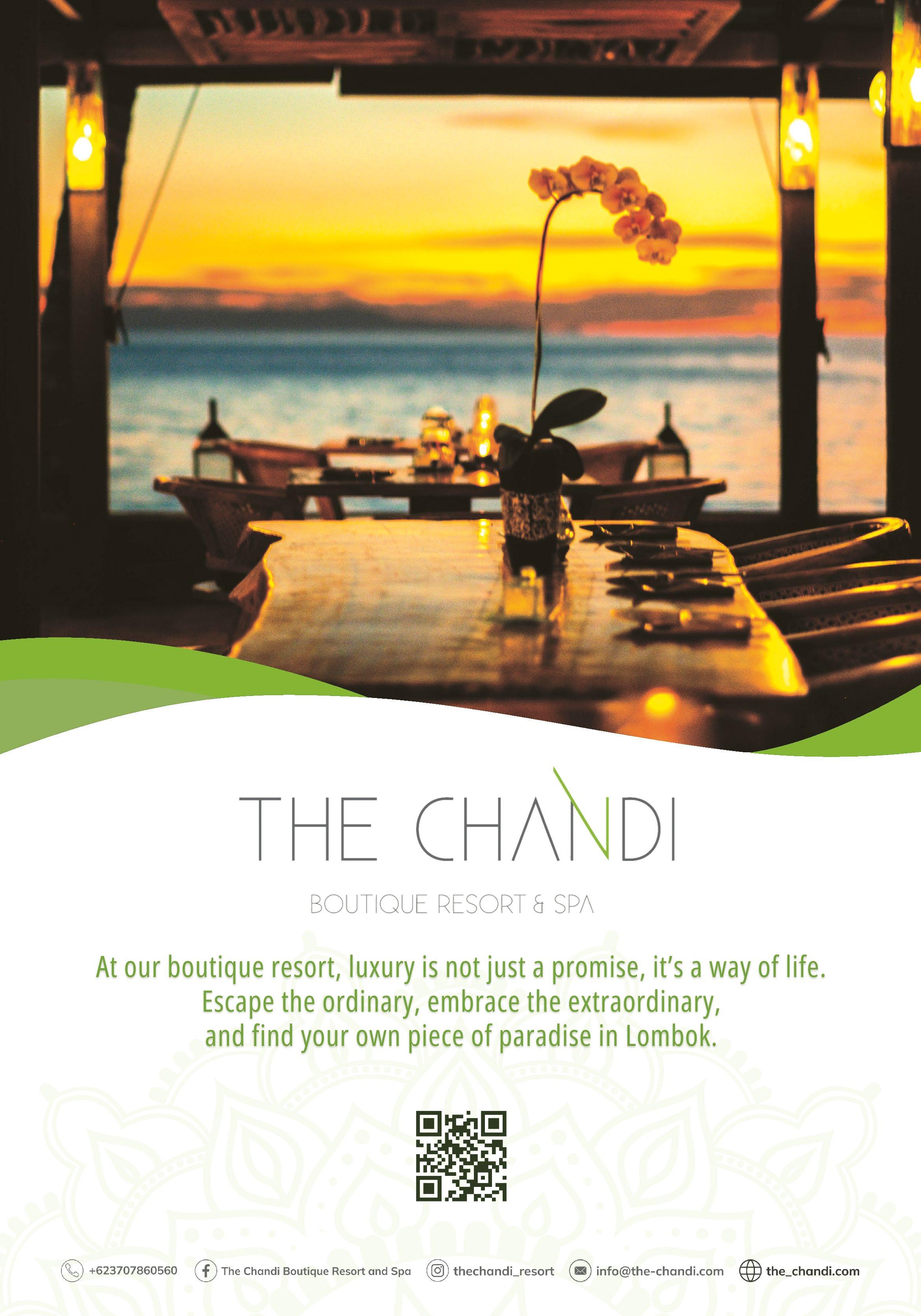
the east, are around an hour’s drive from Senggigi, while the cities are less than an hour away.

Senggigi, with its strategic location, emerges not only as a wonderful holiday destination but as a gateway to the myriad attractions that Lombok offers.
Senggigi is the oldest established tourism area on Lombok’s West Coast and is around a one-hour drive northwest of Lombok International Airport.
Its central location makes Senggigi an ideal base for exploring the island. The waterfalls, golf courses, Lombok Wildlife Park and other attractions in the north are only an hour or so drive away and Bangsal Harbour (the main harbour for boats to the Gilis) can be reached in less than an hour.
The historic attractions of Lingsar and Narmada, and Benang Stokel Waterfall to
The Senggigi tourism strip stretches for about 10km, starting a few kilometres before central Senggigi and running north along the coastal road, with many hotels and restaurants positioned along the beautiful beaches that line the west coast.
A few kilometres south of Senggigi, The Hill (locally called The Bukit), is a residential community perched on the hillside in Batu Layar. The homes and villas here feature architectural designs and have magnificent views over the ocean.
Closer to Senggigi, Batu Bolong forms a strip between the historic Batu Bolong Temple and the southern gateway to Senggigi.
Pura Batu Bolong (literally meaning “rock with a hole”), was renovated in 2010 and is an interesting Hindu temple on a
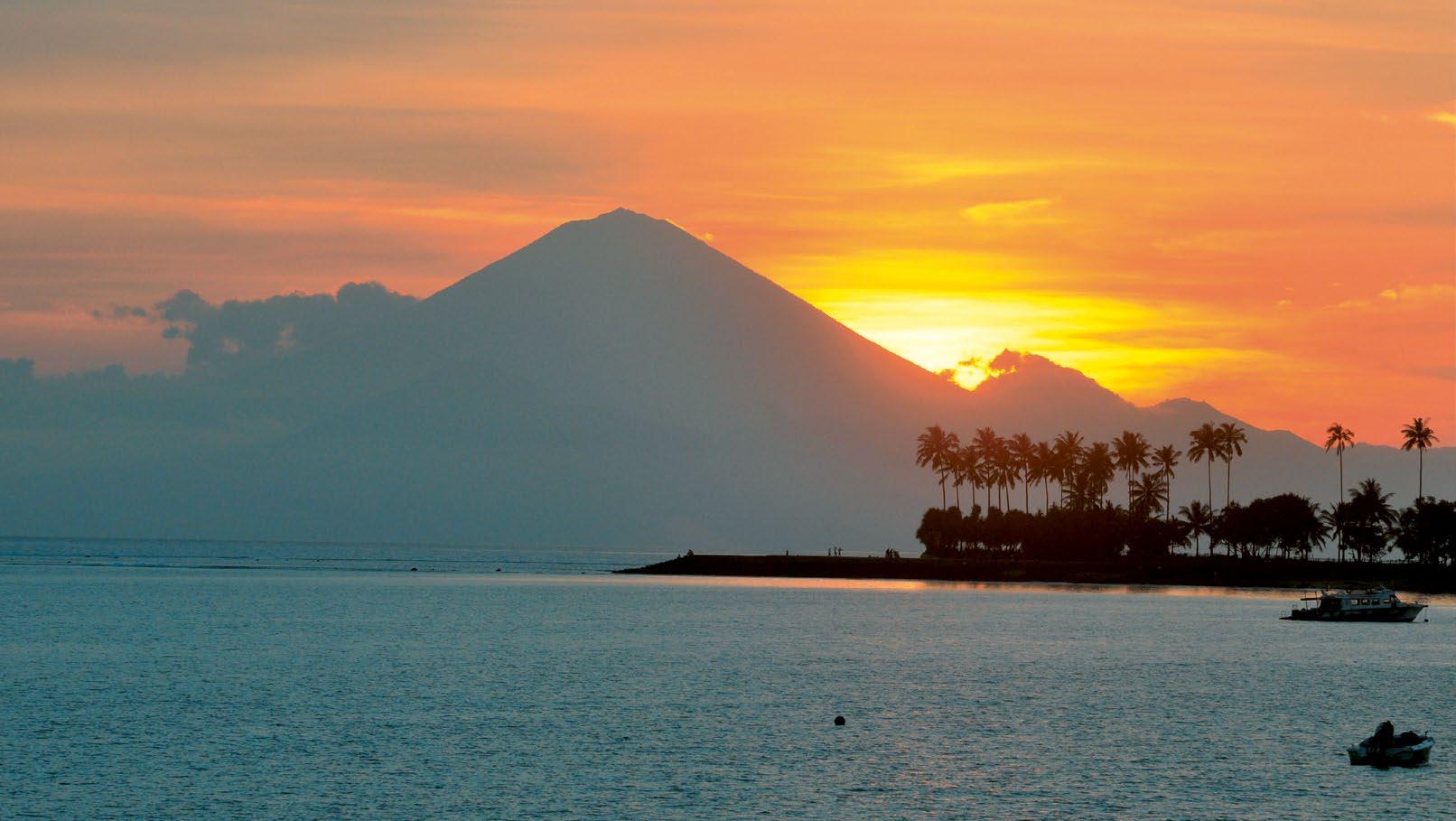
cliff facing Bali across the Lombok Strait. Built on a large rocky outcrop with a hole at the base, from which the temple takes its name, it is said that virgins were once sacrificed to the sea from the seat-like rock at the outermost point.
Colourful Hindu ceremonies are held here every month at the dark and full moons, and at Hindu festival times. Admission and rental of a compulsory sarong and temple sash is by donation. This is a great place to watch the sunset, with fantastic views across the ocean to Gunung Agung on Bali
Just before the entrance to Senggigi. directly across the road from Café Alberto is the entrance to the Green Valley residential area.
Senggigi Beach is the large bay that forms the centrepiece of Senggigi. The main road runs parallel to the beach and large resorts occupy the space between, with Merumatta Senggigi at the southern end and the Sheraton Senggigi Beach Resort at the northern end of the bay.
One of the most spectacular sights on the island is the sunset viewed from Senggigi and along the west coast, which faces toward Bali across the ocean. It is a magical sight watching the bright orange sun sinking into the sea and Bali’s Gunung Agung volcano silhouetted on the horizon like a giant pyramid floating in the ocean.


Continued from Page 16
The beach is a wide protected bay with promontories at each end. The beach is lovely for swimming and relaxing but can become crowded on Sundays and public holidays.
Roughly in the centre of the bay is the Senggigi Jetty where the fast boat from Bali arrives and departs. Visiting yachts often anchor in the calm waters of the bay.
In the early mornings, enjoy a stroll along the beach looking out to the ocean dotted with the bright, colourful sails of fishing boats, as the local fishermen return with the day’s catch.
Senggigi Reef, off the southern point, has good coral for snorkelling during high tide. To the left of the reef, Anjungan is a popular surf spot and, in the right conditions, has some decent surf breaks. When the tides are high, local surfers can be seen catching the waves here every day.
Canoes can be hired from the beach on the weekends and during peak tourism times. Local outrigger boats (perahu) can be chartered from the beachfront for trips along the coast or out to the Gili Islands. In the centre of the bay is the Pasar Seni (Art Markets) with small shops selling handicrafts, clothing, sarongs, jewellery and other souvenirs. Lining the beach side of the Markets are small restaurants for dining. Come for a drink at sunset and enjoy delicious meals from the beachfront restaurants with the waves lapping only metres away.
Away from the beach, the main road (Jalan Raya Senggigi) is lined with cafés and restaurants, shops, spas, tour agencies, bars and nightclubs; many of which have live music in the evenings. There are convenience stores and supermarkets, numerous ATM’s, banks, money changers, a post office and other tourist facilities.
About 2 km north of central Senggigi, Kerandangan has a popular beach nearby and a road leading into a residential area situated in a pretty valley.
At the end of the road through Kerandangan Valley is the Taman Wisata Alam –Kerandangan Nature Reserve – with hiking paths leading through the rain forest along the river. There is a Ranger’s hut and basic visitors centre near the entrance. The Park boasts a small waterfall, pretty river scenery, families of local monkeys, and a variety of tropical plants and birdlife.
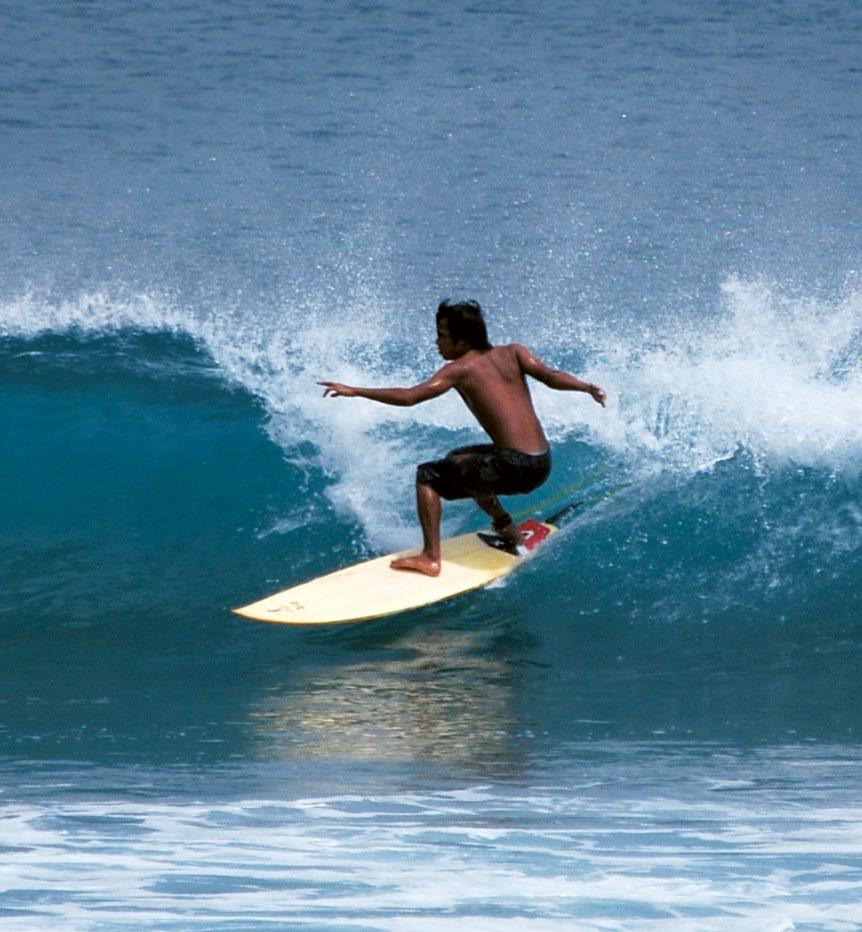
way north along the main coastal road. Malimbu and Nipah are two picturesque bays less than half an hour from Senggigi, which are good for snorkelling, swimming and getting away from it all.
Further north, Mangsit has developed as an accommodation alternative to Senggigi, with some of the best boutique hotels positioned along the breath-taking beaches of this section of coast.
There is good snorkelling in front of Puri Mas Beach Resort at high tide and, when the wind is right, surfers take to the waves in front of Qunci Villas.
Furthest north is Klui, Lendang Luar and Setangi, with a long stretch of pristine beach at Lendang Luar.
Mainly deserted white sand beaches, flanked by coconut groves continue all the
Whether you are seeking a tranquil interlude with luxury accommodation at a top resort with fine dining and spa facilities, or a budget holiday with days spent exploring – or all the choices in between – Senggigi caters for all tastes and budgets.
Swim, snorkel, dive, hike, lie in the sun, have a massage, eat and drink at some of the great restaurants and bars in town; or just take a break and be enchanted by the unspoiled beauty of Lombok’s west coast.



Comfortable and pocket-friendly accommodation right in the heart of Senggigi and just a few minutes walk to the beach!
Air conditioning, free WiFi, Bar and Restaurant. Rooftop Swimming Pool with fabulous sunset views!

The
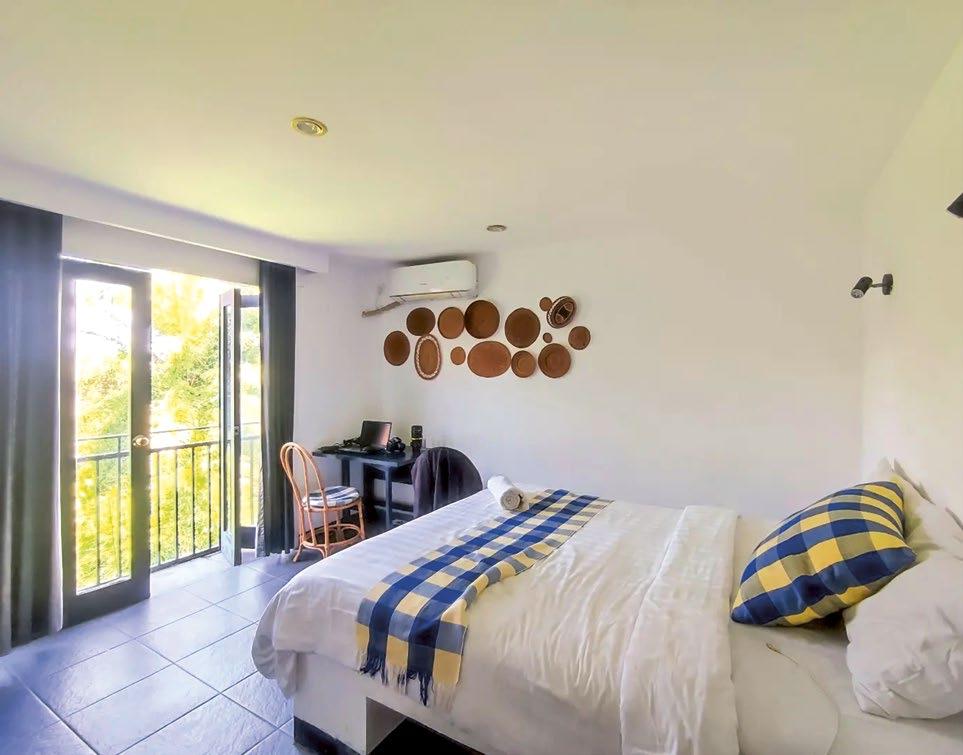
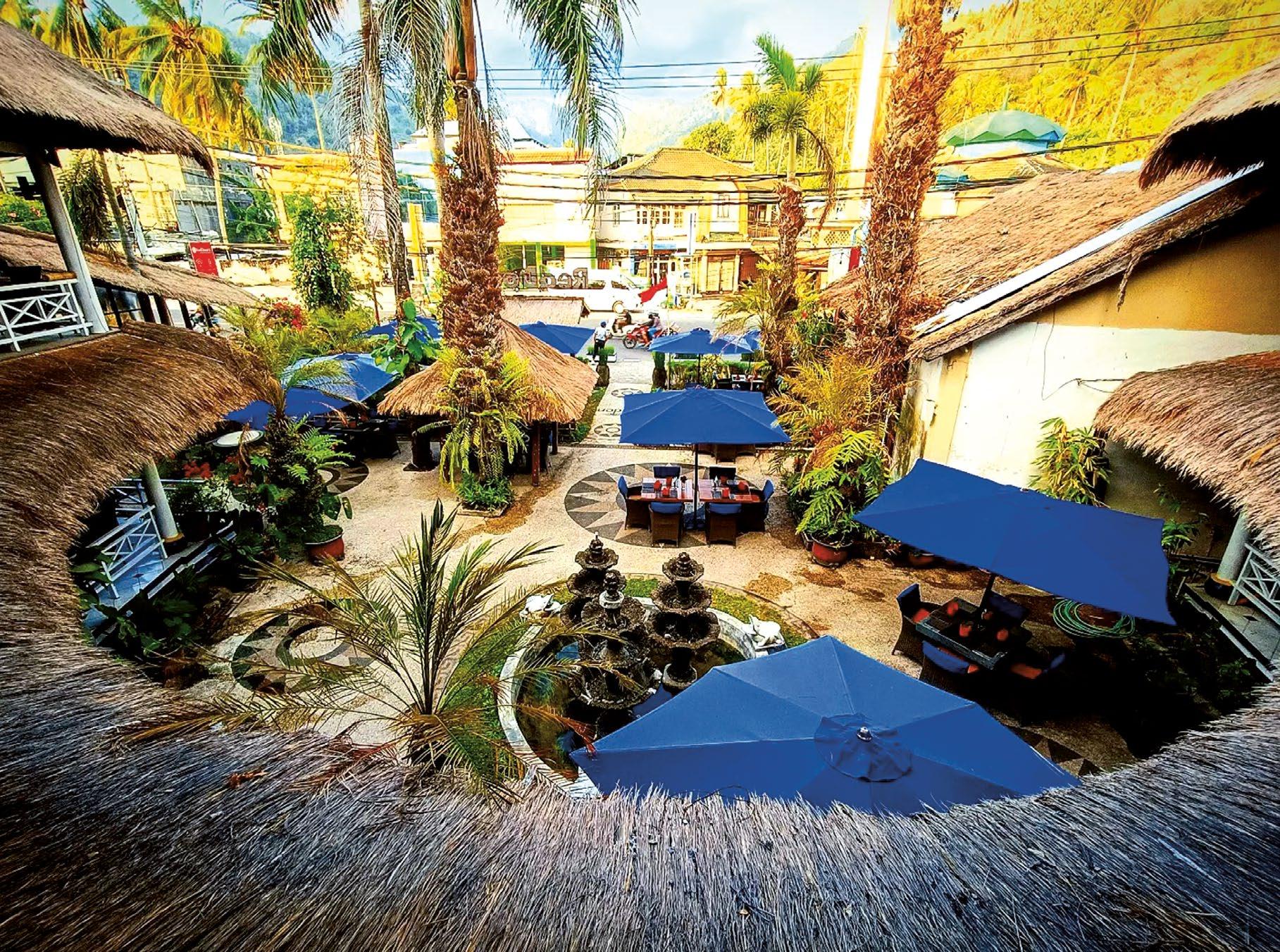




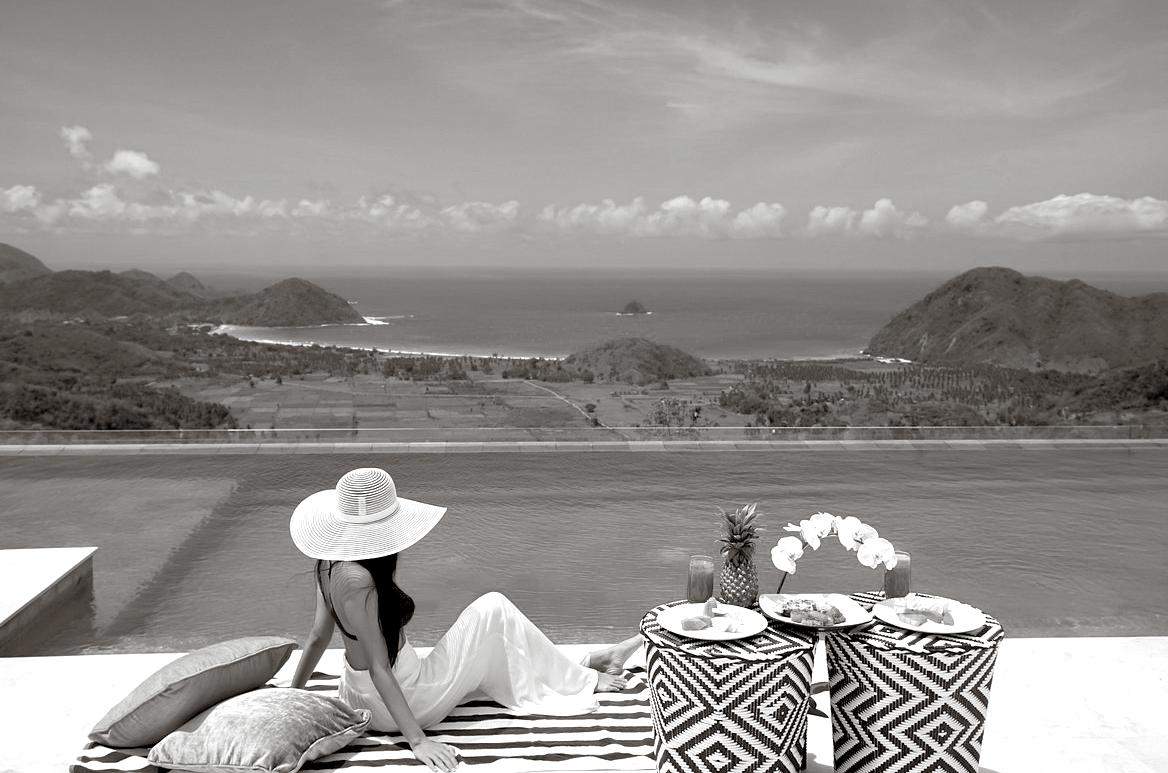
• Beautiful Selong Selo Residences is a stylish and popular destination in South Lombok. Guests come to admire the breathtaking views overlooking Selong Belanak Beach, to dine on innovative and modern cuisine at Aura Lounge and Bar, and to soak up the elegant ambience of one of the south coast’s premier resorts.
the Cellar Party features three hours of free-flow selected red and white wines, together with a delicious buffet including sushi, stir fries, pasta, roast meats, salads and desserts.
Price is IDR 575,000 nett (all inclusive) or you can choose the ‘buffet only’ option for just IDR 275,000 nett per person. See advert on page 9 for contacts.
• Finding good quality building supplies, and modern home fixtures and fittings in Lombok isn’t always easy but now a new building supply supermarket has made it easy for home-owners!
Index Bangunan in Sweta has a huge selection of building materials and hardware, including flooring, granite and ceramic tiles, paints and sealants, lighting, bathroom and kitchen fittings, sinks, toilets, handbasins, bath tubs, imported taps and shower heads, pumps, water tanks, water heaters, and more.

Accommodation at the resort comprises 35 luxurious and spacious architecturallydesigned villas, ranging from studio to 7-bedroom, all with private pools and spectacular views. Perfect for couples getaways, special occasions and family breaks!
As a special deal for Lombok residents, you can enjoy 25% off best available rates from now until 15 December 2024!
The offer includes complimentary upgrade to next villa category, welcome drink, daily breakfast at Aura, free WiFi, and 20% discount on food and beverages.
This offer is only open to Lombok residents and terms and conditions apply. Email reservations@selongselo. com or WA +62 858 8322 0688 for more information.
• If you are in Senggigi at the beginning of the month, you shouldn’t miss the Cellar Party at Square Restaurant! Held on the first Friday of every month from 7 - 10pm,
There’s also a good selection of top brand power tools, garden equipment and furniture, and more household items than we can list!
At the moment Index Bangunan is offering our readers a voucher for 30% discount and free delivery in Mataram. Make sure you cut out the voucher on page 42 and present it when shopping.
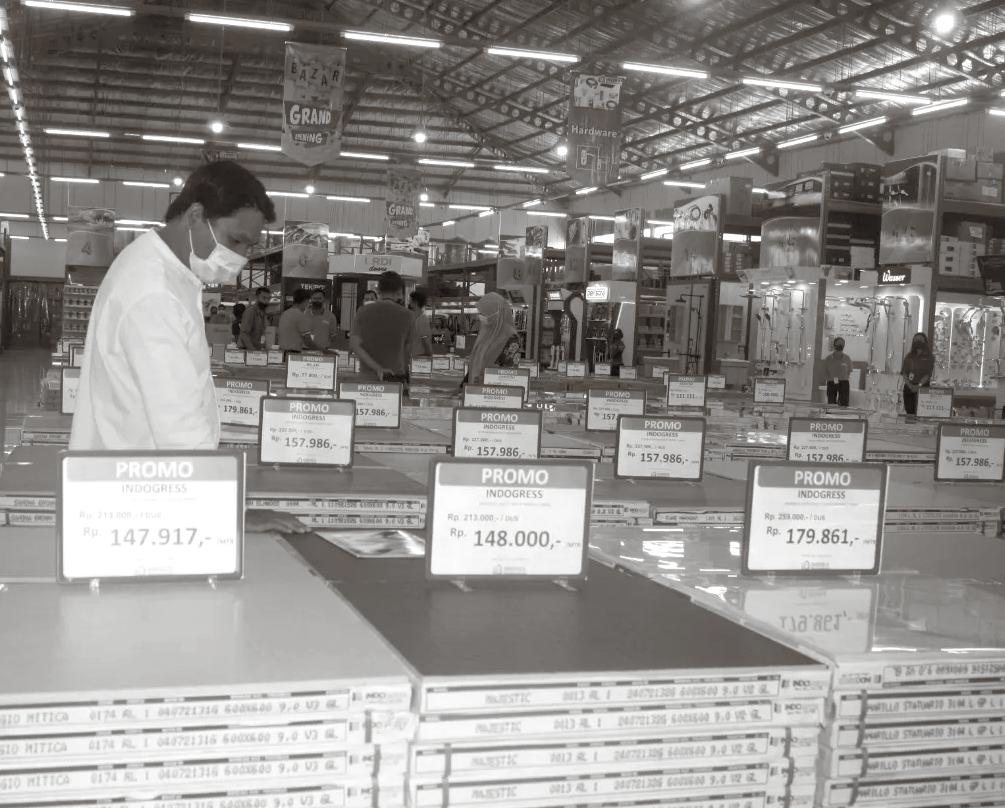















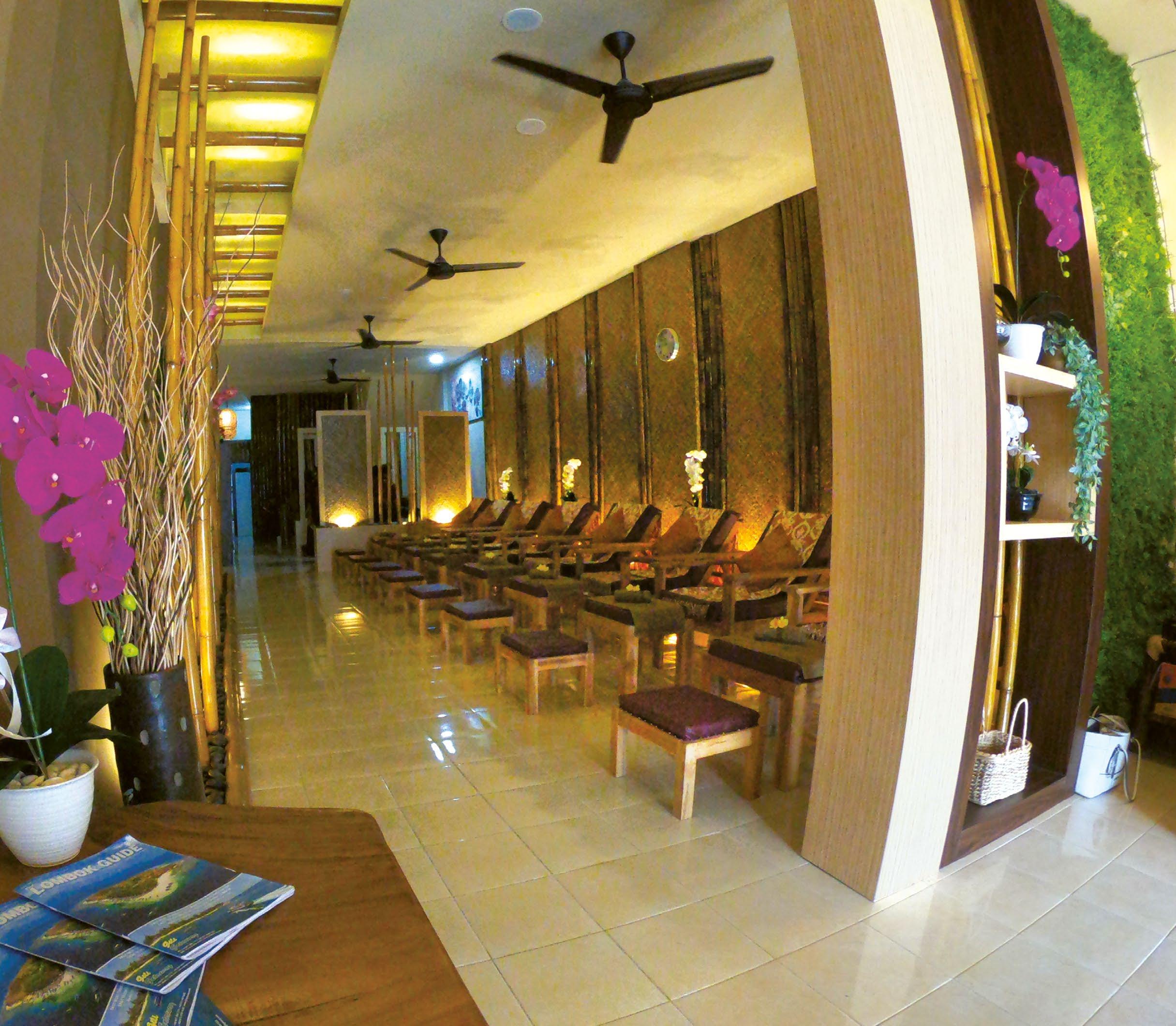
ONE HOUR MASSAGE ONLY Rp 120,000 NET
Massages, Reflexology, Facials, Hair Treatments, Manicures & Pedicures, Gel Nails and more
COMPLETE SPA SERVICES AT LOCAL PRICES!
ORCHID PACKAGE 1
Massage, Body Scrub, Body Mask, Face Therapy Rp 350,000 net / 2 hours
ORCHID PACKAGE 2
Massage, Body Scrub, Body Mask, Face Therapy, Manicure, Pedicure Rp 450,000 net / 3 hours







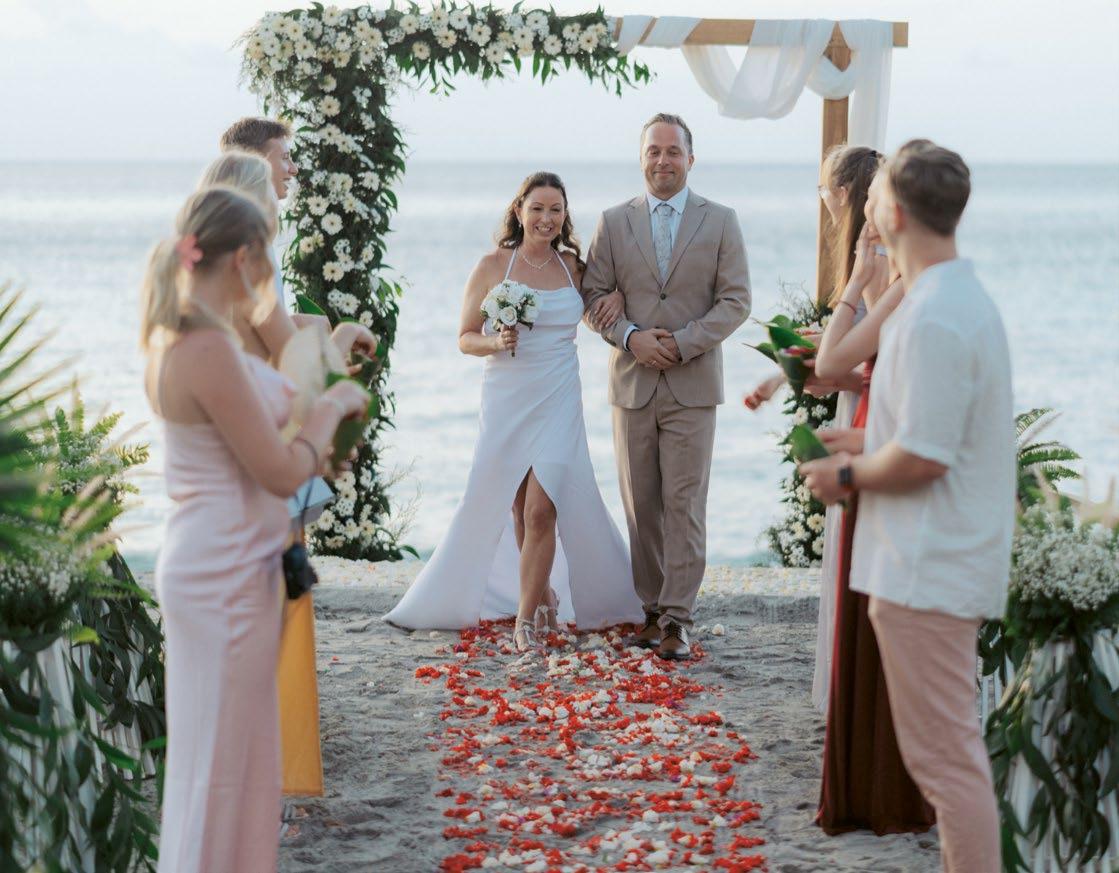
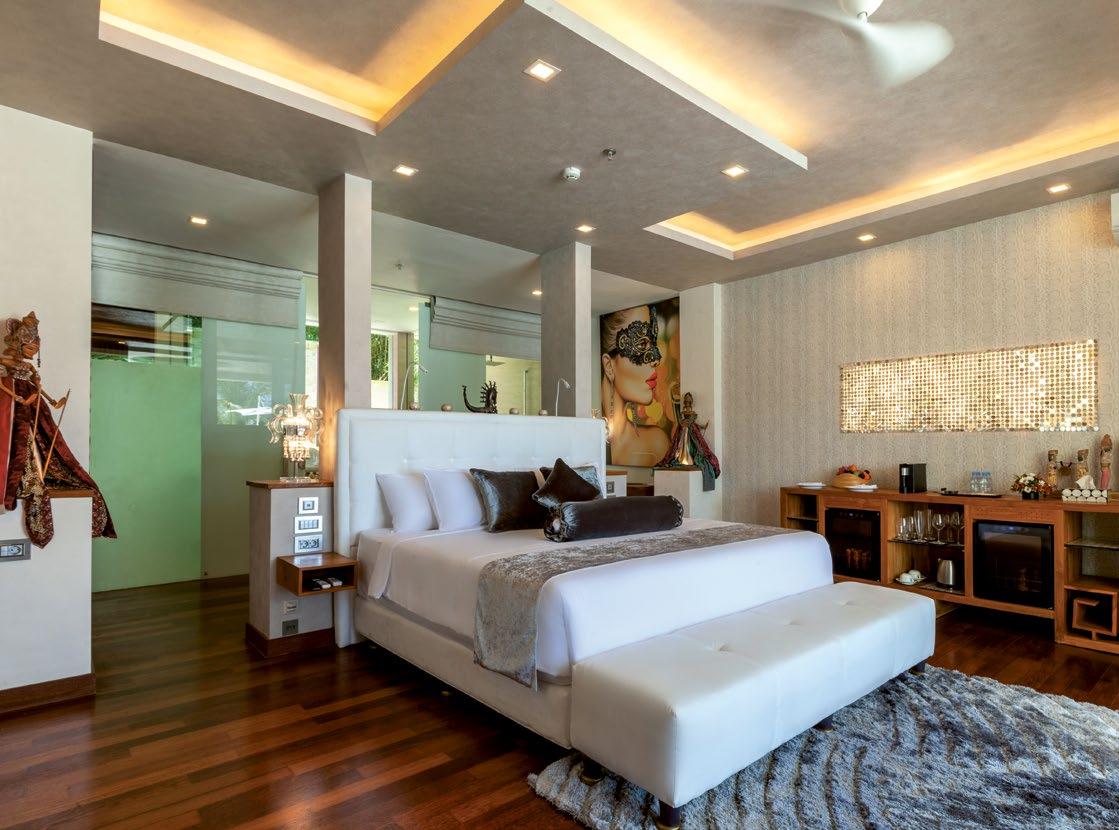
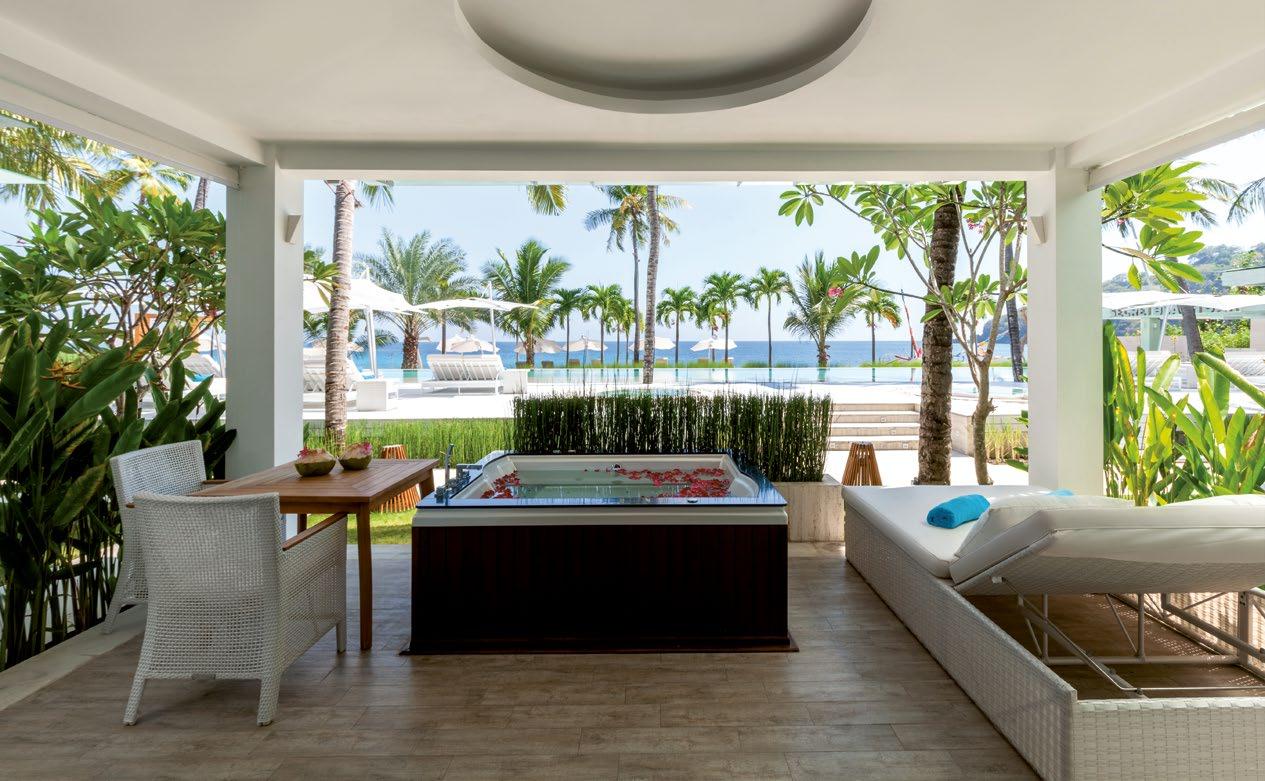
Seven Secrets by Hanging Gardens is a true tropical beach sanctuary featuring luxuriously appointed suites on a pristine, undeveloped beach with fantastic views across the ocean to Bali.
Perfect for honeymoons, special celebrations, weekend escapes, relaxation and wellness stays.
Book Direct And Enjoy Additional Privileges!
PH/WA: +62 813 3947 9482
Jalan Raya Pemenang KM 10, Nipah Bay, Malaka, North Lombok
Ph: +62 370 6193 688 / +62 370 6198 558
www.sevensecretsresorts.com

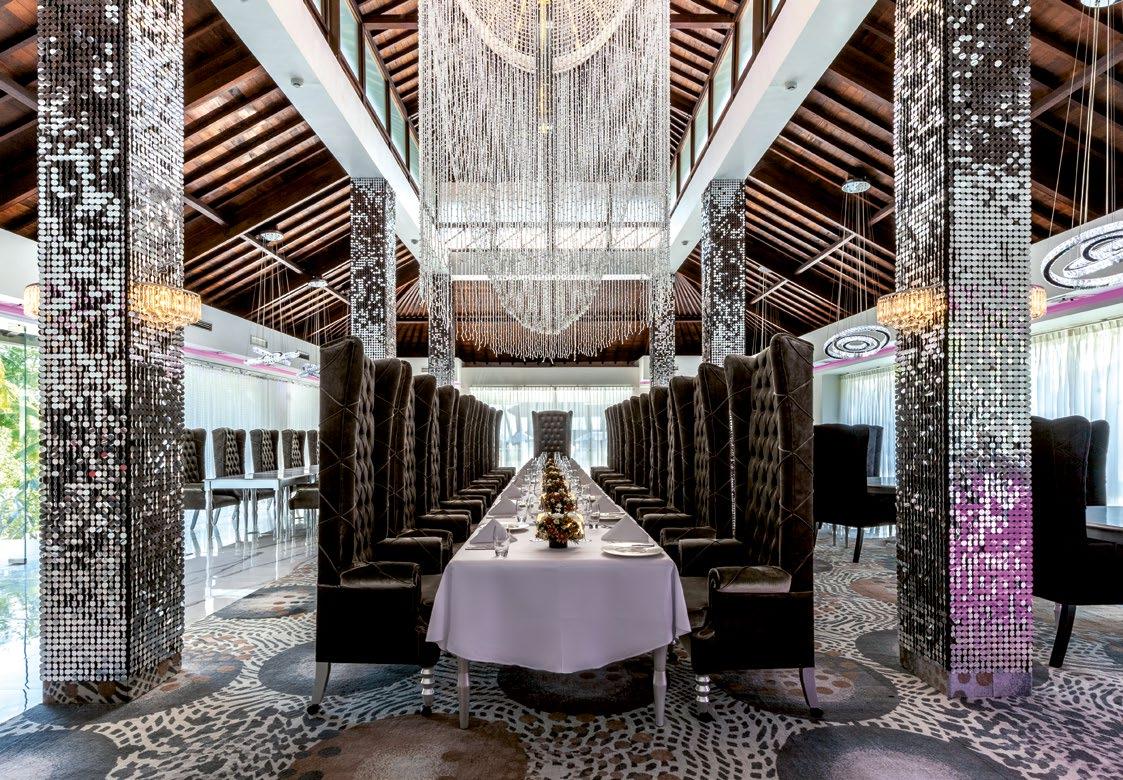
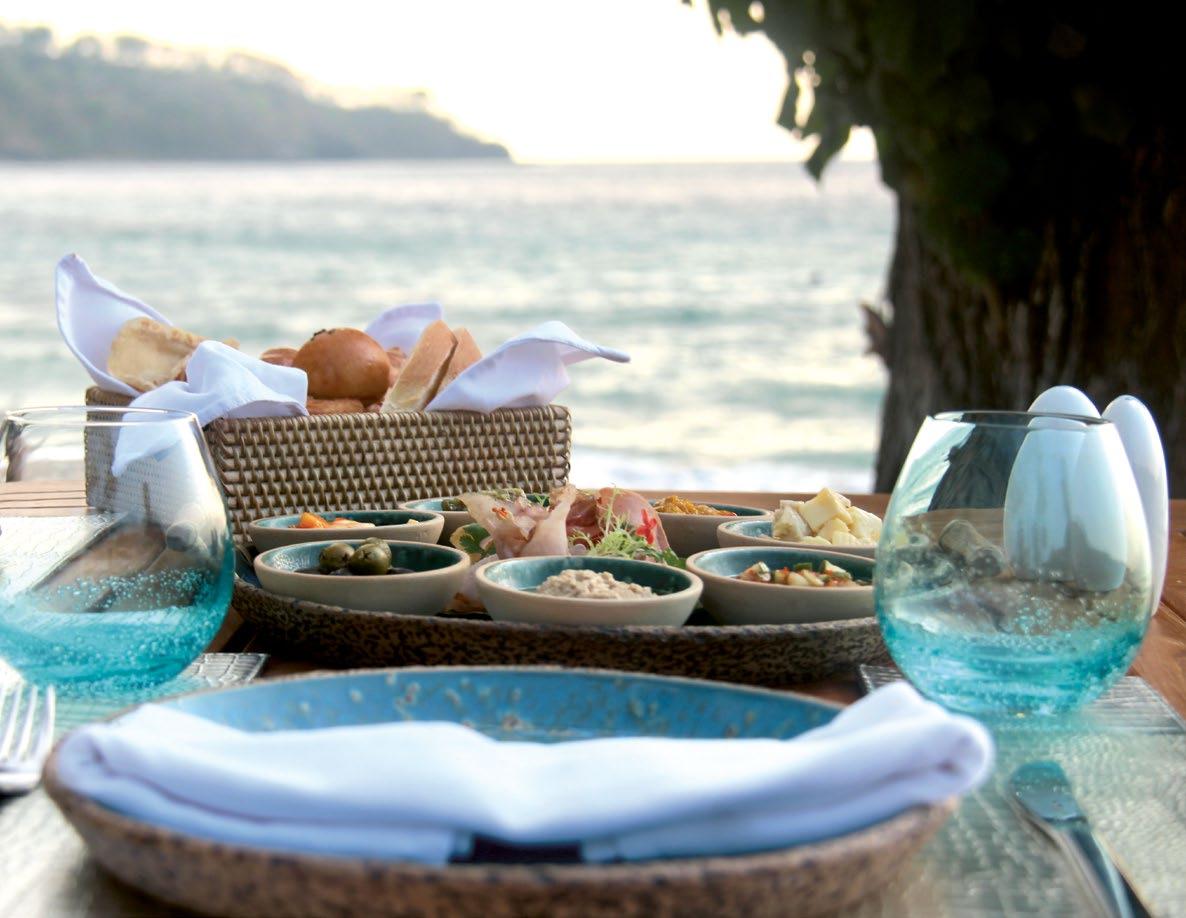


Dine in splendour at The Majesty Fine Dining Restaurant, offering an exceptional dining experience paired with a carefully curated wine list and superb service.
Savour a coastal culinary adventure at L'Angelo Bianco, our beachside restaurant offers fresh sea breezes, a relaxed ambiance and innovative seafood dishes. Open for breakfast, lunch, dinner and all day dining.
From morning to evening, delight in our Secret Beach Swim-up Bar serving refreshing cocktails, wines, beers and mouth-watering tapas.

Seven Secrets by Hanging Gardens hosted an exclusive event last month to showcase the outstanding features of one of Lombok’s most luxurious resorts.
Located on beautiful Nipah Beach, Seven Secrets offers true beachfront luxury stays in a unique environment. In more developed countries, this wide sweeping bay would be lined with resorts and hotels but Seven Secrets is currently the only hotel occupying this prime beachfront on Lombok’s northwest coast.


This intimate, all-suite boutique resort offers an extraordinary level of comfort in each of the 24 ocean view, garden view and mountain view suites, combining lavish amenities with high-end smart technology, including elegant interiors inspired by renowned designer Robert Cavelli, retro Marshall sound systems and jacuzzis on each balcony.

The resort’s swimming pool takes full advantage of its location, overlooking a truly private beach with breath-taking views across the ocean to Bali. Surrounding the pool are custom sun lounges with adjustable shades, unique dome-shaped cabanas and a poolside jacuzzi.
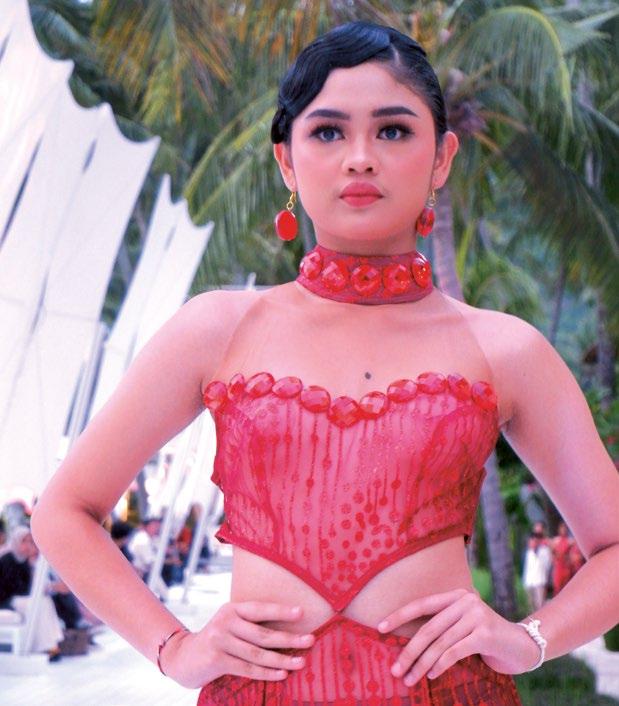
No detail at the resort has been left untouched. Magnificent Swarovski crystal chandeliers cascade from the ceilings in the Secret Spa and the resort’s signature Majestic Restaurant.
Concealed lighting, that changes colour to create different moods, illuminates the gardens, buildings, pool and beachfront at night. The fabulous gym boasts the latest state-of-the-art equipment.
L’Angelo Bianco beachfront restaurant and the discreet butler service provide “any time dining” options so that guests can spend the entire day soaking up the sun and the relaxing beachside surroundings, while Secret Beach Swim-up Bar mixologists are ready with drinks, snacks and cocktails.
Invitees at the “Sunset Cocktails and Dinner” event in early March enjoyed cocktails and canapés around the pool while viewing a fabulous fashion show featuring local designers Bali Citra Kebaya, Patemar, Asal Designer, and Inges Boutique.
As an antidote to mass tourism, it’s wonderful to see small personalised resorts and bespoke experiences taking centre stage in Lombok. Seven Secrets by Hanging Gardens has certainly set the bar high for stylish stays on the island.


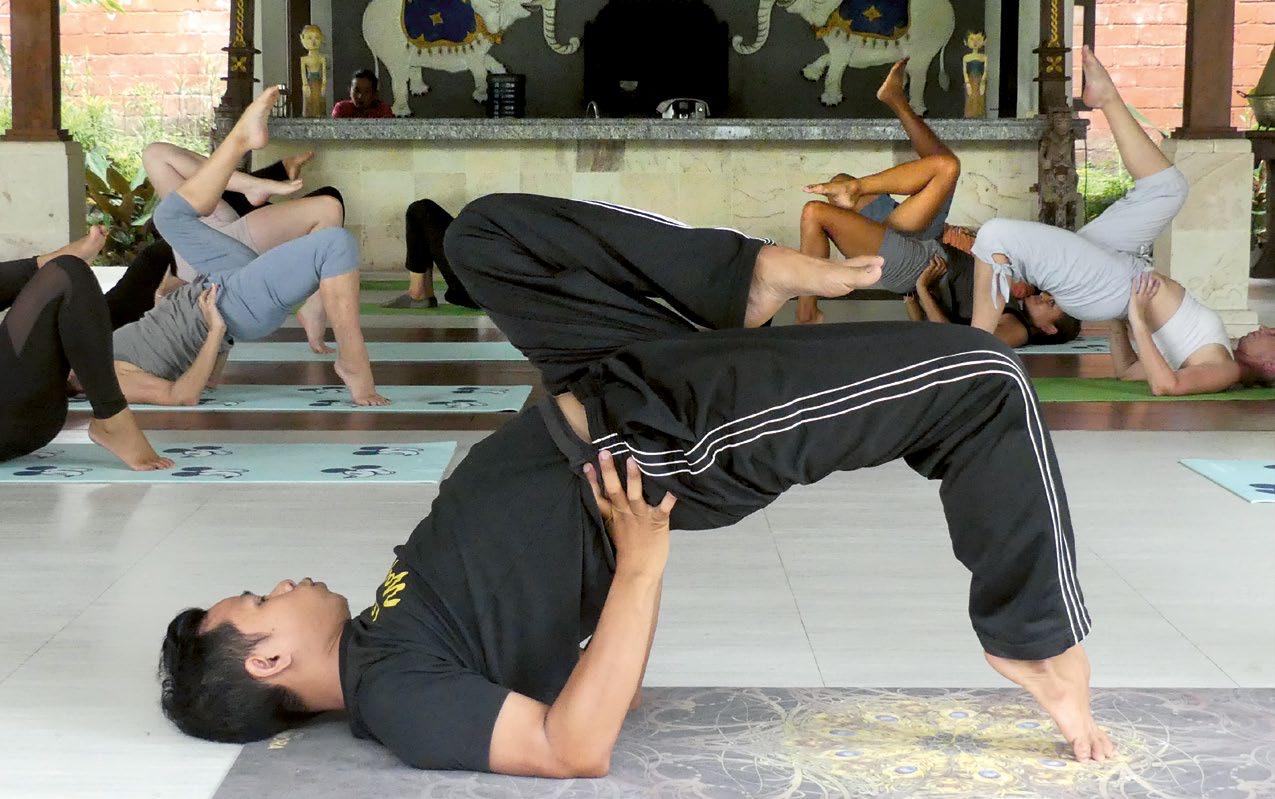

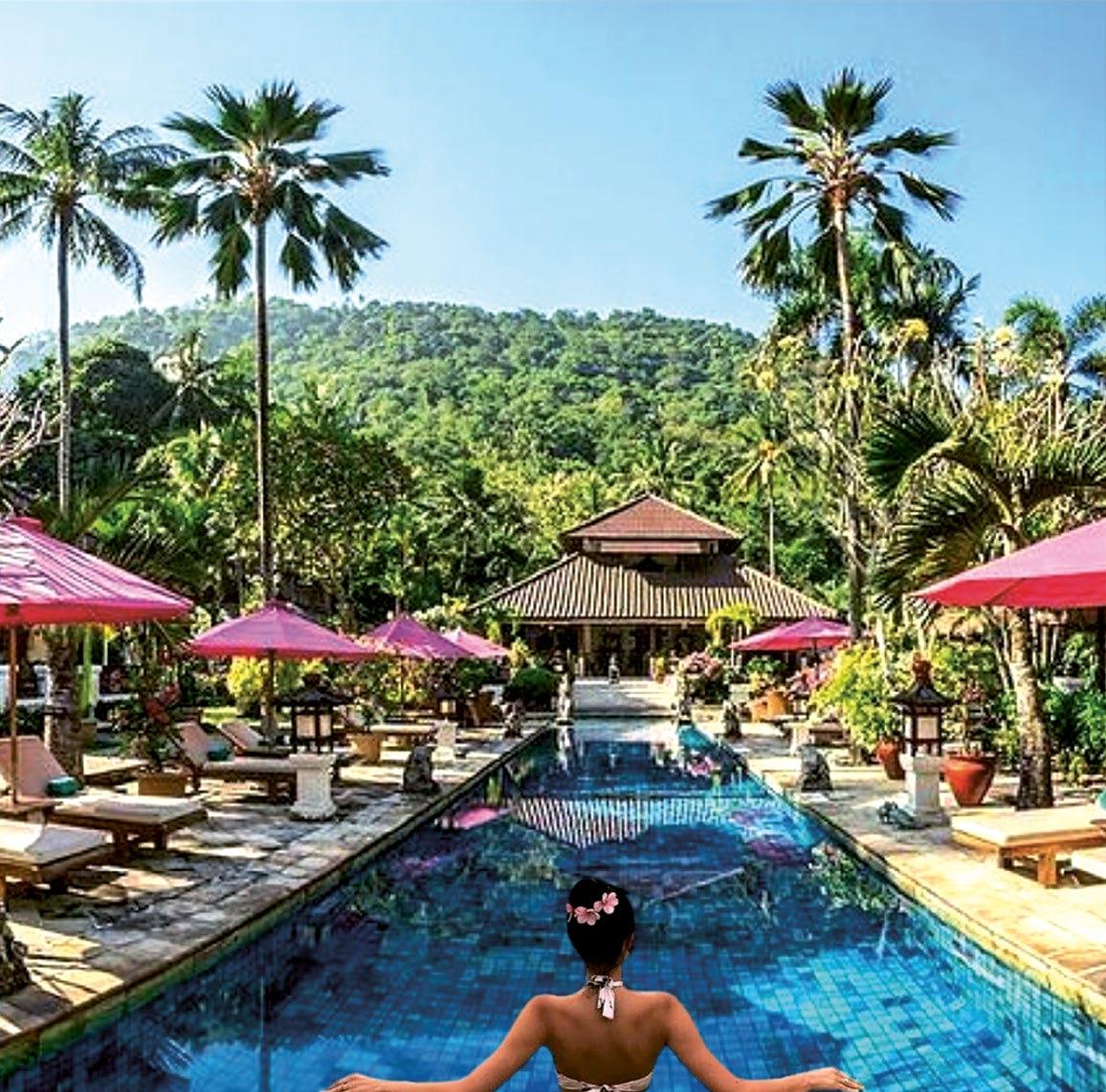









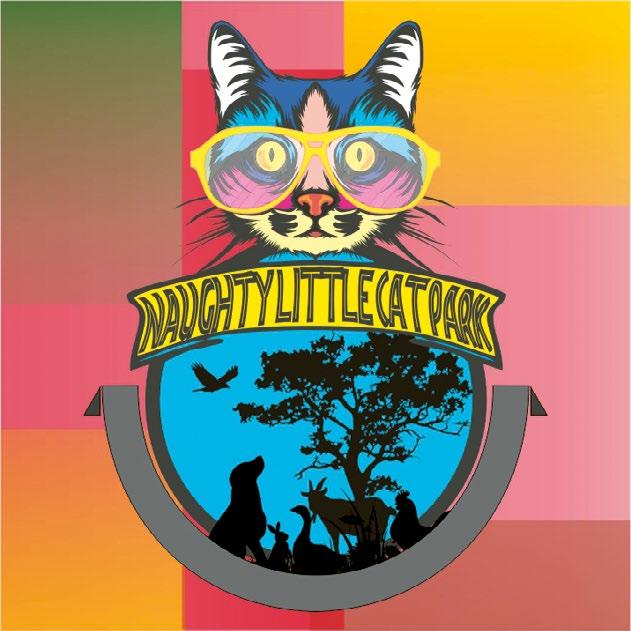


As we go to print this year, the fasting month of Ramadan is due to end around 9 April and, for those who are in Lombok at this time it’s a great opportunity to join in the celebrations!
Idul Fitri (or Eid al-Fitr) – known as Lebaran in Indonesia – is the most important holiday of the year, as the whole nation celebrates the end of the fasting month.
The first two days of Lebaran (10 and 11 April) are especially happy occasions. Similar in spirit to Christmas for westerners, Lebaran is the time for all the family and friends to get together and celebrate.
More than one hundred million people will be travelling to reunite with their families in the days before Idul Fitri. This holiday exodus is known as Mudik. People working in the far-off islands, as well as many of those working abroad, will try to come home at this important time – for many it is the only time in the year that the whole family will be together.
For those travelling during this time, it’s important to be aware that flights are often booked out weeks in advance. Airports, terminals and harbours will be crowded and traffic on the roads will
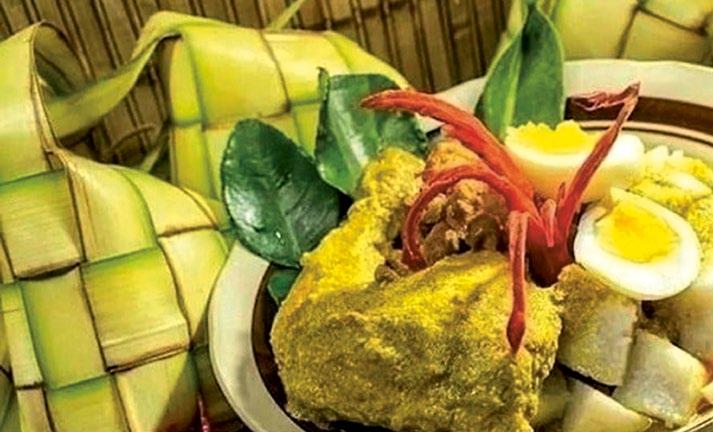
be heavy for the week before and after Lebaran. Expect delays. Peak period is from 3 -18 April.
Lebaran is a time of happy reunions and people greet each other, saying “Mohon ma’af, lahir dan batin” – meaning to ask forgiveness for any wrong-doings throughout the previous year. It is a way to let bygones be bygones and to start afresh.
The first day of Idul Fitri starts with early prayers at the mosque and then the day is spent visiting families and friends; celebrating the end of a successful fast, renewing bonds and eating festive foods together.
People in Lombok will often visit cemeteries together to freshen up the graves of family and friends who have passed away, to pray and remember their spirits at this special time of the year.
Of course, everyone dresses up in their best clothes for the day and many will buy a new special outfit (baju Lebaran). Traditional batik is particularly popular.
In the weeks before Lebaran, you’ll see clothing stalls set up everywhere, and the shops and malls in Lombok are packed with people buying special outfits for the celebrations. Competition is fierce with discounts and sales, and it’s a good time to pick up a bargain!
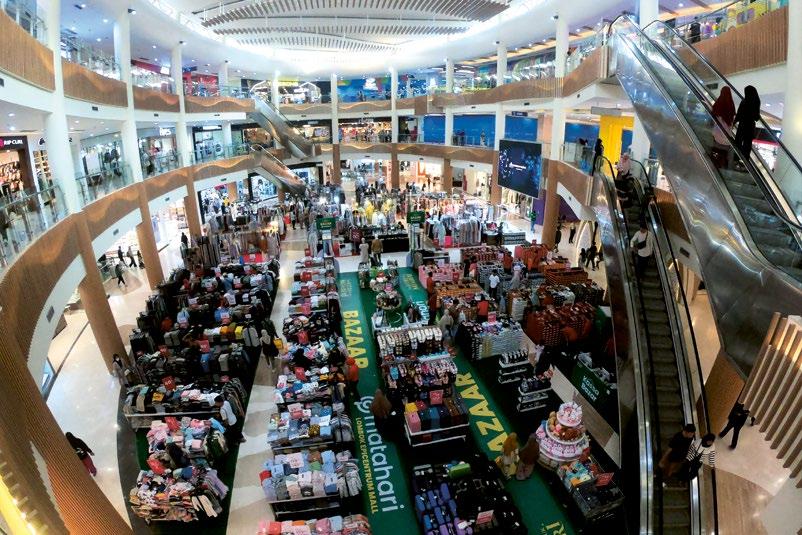
There are also special feasts to prepare and tables loaded with festive goodies to share with visiting family and friends. These are served at every house you visit and, as it is impolite to refuse, you will end the day feeling very full!
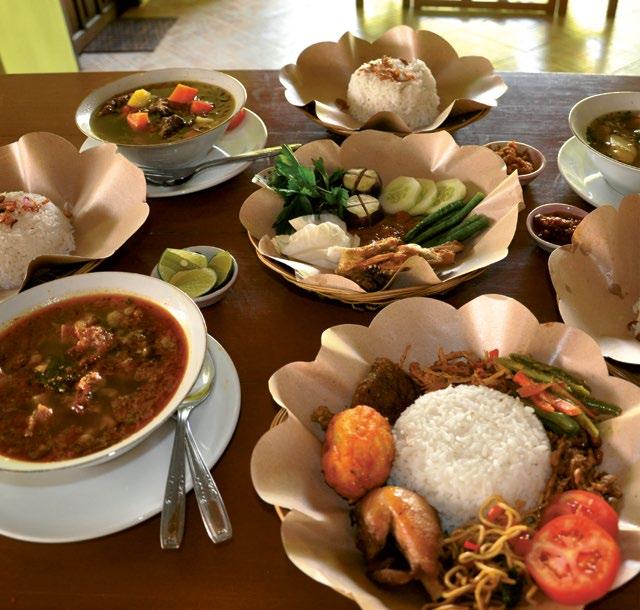
If you are invited to local homes during this time, don’t miss the opportunity to share in the happiness and feasting on delicious traditional foods and treats!

PAWAI TAKBIRAN, or the Takbiran Parade, is celebrated throughout the towns and villages of Indonesia in recognition of the successful completion of the holy fasting month and heralds the start of Idul Fitri.
Starting in the evening on the last day of Ramadan and continuing throughout the night, bedug drums are beaten at sunset (maghrib) to signal that it is time to break the fast.
The communities then assemble for loud and boisterous parades, which include drumming accompanied by amplified prayer, chanting and lively Islamic music. A couple of weeks before Lebaran, community groups gather together to construct displays for the parade. These will include models of mosques, holy characters and other Islamic symbols. Some of the floats are quite elaborate, featuring detailed miniature mosques, complete with carefully painted minarets and domes.
Takbiran itself is traditionally a “lantern festival”, or a festival of light, and lights feature highly in the parades. Mosques are lit from within, floats glow with fairy lights,

and smiling people dressed in traditional Islamic clothing carry huge glowing letters spelling out words from the Qur’an, or glowing stars and hearts.
The largest parade takes place along the main roads in the city and finishes at the Islamic Centre in Mataram.
The parade culminates with thousands of the Takbiran floats lighting up the night as
fireworks explode overhead. It’s an awesome sight and the festival atmosphere makes Takbiran a fun event to witness.
If you don’t want to make the trip into the city, smaller parades take place along the main roads in all major towns across the island.
The actual date of Idul Fitri depends on the lunar calendar and varies each year. The dates announced at the time of our going to press are 10 and 11 April, so Takbiran should take place on the night of 9 April (but may be later by one day). If you are in Lombok close to this time, ask any local person for the exact date.





The Indonesian government estimates that more than 100 million people will be travelling across the archipelago over the next two weeks, returning home for the holidays.
This will create a lot of congestion at airports and ports, but mostly on the roads, with millions of people travelling by car, motorbike, bus, truck and any form of transport available.
We hope that those who are making the journey for Lebaran take care on the roads and reach home safely.
Mosques can be particularly noisy on the night of Takbiran, with drumming and chanting lasting the whole night. Be aware that it may be difficult to sleep if you are staying near a mosque. Closing windows, using the air conditioner, playing soft music or wearing ear plugs will help.



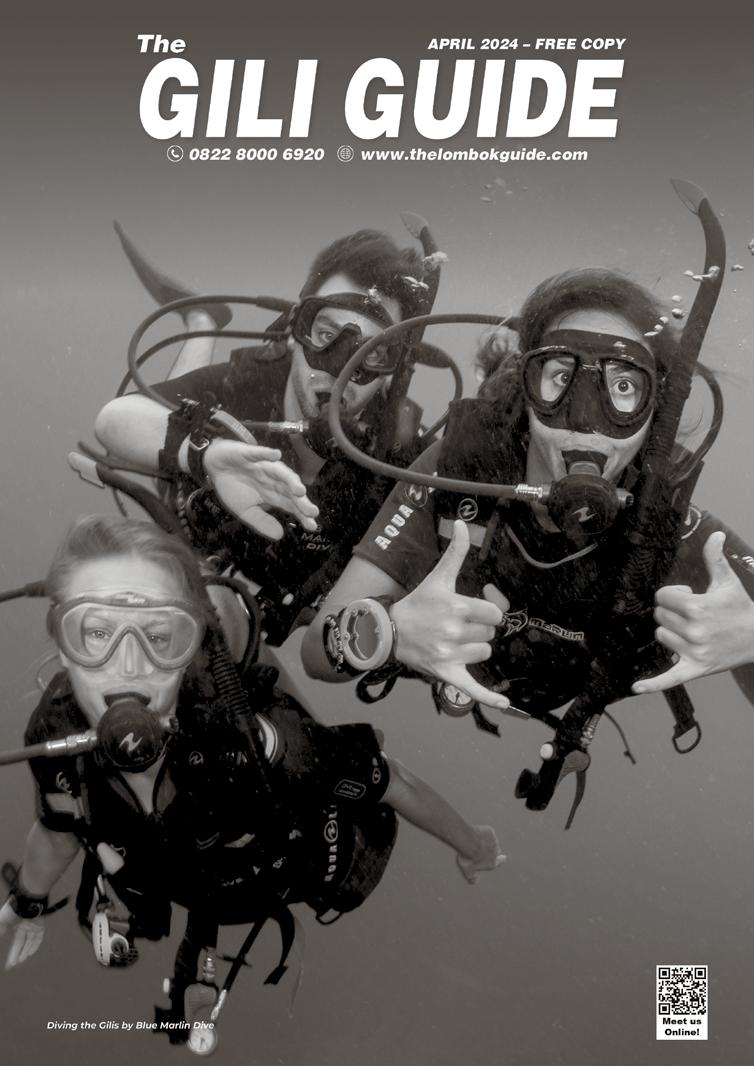








After being closed for the past three months, the Rinjani trekking season officially re-opened on 1 April and people are already flocking to climb Lombok’s iconic volcano!
The Rinjani National Park Authority closes the trekking routes every year from 1 January to 31 March during the worst of the monsoon season.
Mt Rinjani soars 3,726m above sea level and is the second highest volcano in Indonesia. Every year over 100,000 visitors from around the world come to Lombok to climb the volcano; either to its aweinspiring crater, or to the demanding summit with its panoramic views across the ocean to Gunung Agung, Bali’s famous sister volcano.
“Gunung” is Bahasa Indonesia for “mountain”.
The two volcanoes create a visual connection for Balinese Hindus living on
Lombok and, historically and culturally, Gunung Rinjani has important significance to Lombok Sasaks and Balinese – Muslim and Hindu alike – and is considered a “Home of the Gods”.
Pilgrimages are often made to the mountain, and many people visit the volcano to pray, and bathe in the pools and hot springs, which are said to have healing powers.
Rinjani is famous not just for its impressive height but also for its incredible beauty. The volcano is surrounded by tropical rainforest on the lower slopes, savannah plains on the upper slopes, and is topped with a jagged peak of rocks on the summit.
The huge caldera near the top of the volcano is around 4 kms wide and is almost filled by a beautiful crescentshaped lake, Danau Segara Anak (Child of the Sea). The lake is around 230m deep and contains plentiful fish, as well as being home to birds and other wildlife.
A smaller volcanic cone, Gunung Baru Jari, was formed a couple of hundred years ago and juts from the crater’s interior at the edge of the lake. It’s been estimated that the force needed to create the new cone and the lake would have been equal to around 300 Hiroshima-type atomic bombs. There are a number of caves, small waterfalls and hot springs located around the volcano, most importantly Aik Kalak on the northeast of the crater, where the volcanically heated waters are said to cure illnesses, particularly skin diseases.
The volcano is so unique and important geographically, Rinjani was awarded UNESCO Global Geopark status in 2018. There are four main routes for climbing the volcano: Senaru in North Lombok, Sembalun and Timbanuh in East Lombok, and the Aik Berik trail in Central Lombok.
Senaru, a pretty village set amongst mountains and jungle in North Lombok,

is one of the two most popular starting points for climbing Rinjani and also the northern gateway to the Rinjani National Park.
Native wildlife, including monkeys and tropical birds, live in the surrounding jungle, as well as abundant varieties of tropical plants and flowers. Sendang Gile Waterfall at Senaru is amongst Lombok’s most spectacular. Sheets of thundering water cascade in a steep vertical drop down the hillside, into a rocky stream below.
The other main starting point for trekking, for a slightly shorter route to the summit, is Sembalun. Located on the northeast side of the volcano, Sembalun’s towering volcanic mountain ranges and deep verdant valleys offer a variety of trekking and camping options and the area is tailored to adventure tourism.
There are a variety of different options for climbing Gunung Rinjani. Two-day, one-night treks are the shortest available, taking visitors to the crater rim, to view the crater and the emerald green lake within.
The most popular is the three-day, twonight trek which allows trekkers to climb down to the lake to camp and enjoy a soak in the hot springs.
Three- and four-day treks include the summit of the volcano, a demanding climb with magnificent views from the highest point on Lombok – taking in the vista of the surrounding mountain range, the lush green landscape below, and the ocean to the west studded with the Gili islands and Bali floating in the distance.
Trekking on the volcano is not for everyone. A certain level of fitness is needed for those intending the three- and four-day treks and climbing to the summit

is particularly strenuous. Time magazine described climbing Rinjani as “difficult, treacherous and extremely worthwhile”.
Altitudes of over 2,700m are reached in all these treks and, even on the equator, night time temperatures can be very cold, with strong winds and occasional rain.
The best time to climb Gunung Rinjani is in the dry season from April to October, or before the rainy season starts. The sunny days and cooler temperatures make this time of the year the most comfortable for climbing, and enable the clearest views of the stunning scenery both on and around the mountain.
• Treks can be organised online or at tour offices in Senggigi, Senaru, and Sembalun. Typical treks include an experienced guide, porters to carry equipment, water, food and cooking utensils, and tents and sleeping bags.
• Use good quality, comfortable shoes and take a walking stick to help with the inclines. Make sure you have a warm jacket, spare

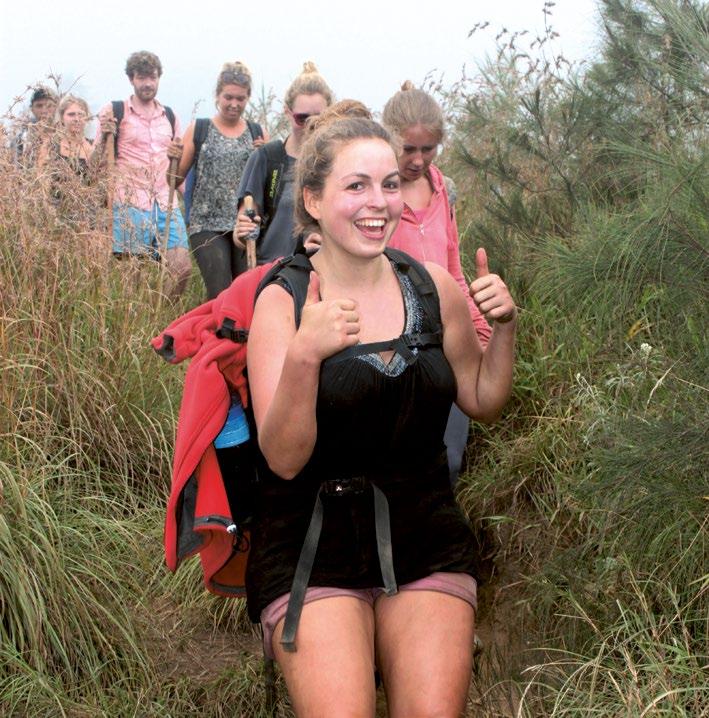
socks and enough clothes – it’s cold on the mountain.
• Don’t try to save money by trekking on your own or using unauthorised guides. Licensed guides will have identification, and are experienced to handle your trek and the conditions on the mountain.
• Over the coming months, thousands of people will climb the volcano every day. This equates to potentially tonnes of waste being dumped on the trails leading up the mountain. Before agreeing to book a trek, check if the local company will bring all rubbish back down at the end of the trek. If they don’t, find another company… there are plenty available.
If you love this natural wonder, the solution to rubbish is in your hands – if you trek it up there, do the right thing and trek it down again.

 Aik Kalak Hot Spring
Trek to the Summit
Aik Kalak Hot Spring
Trek to the Summit
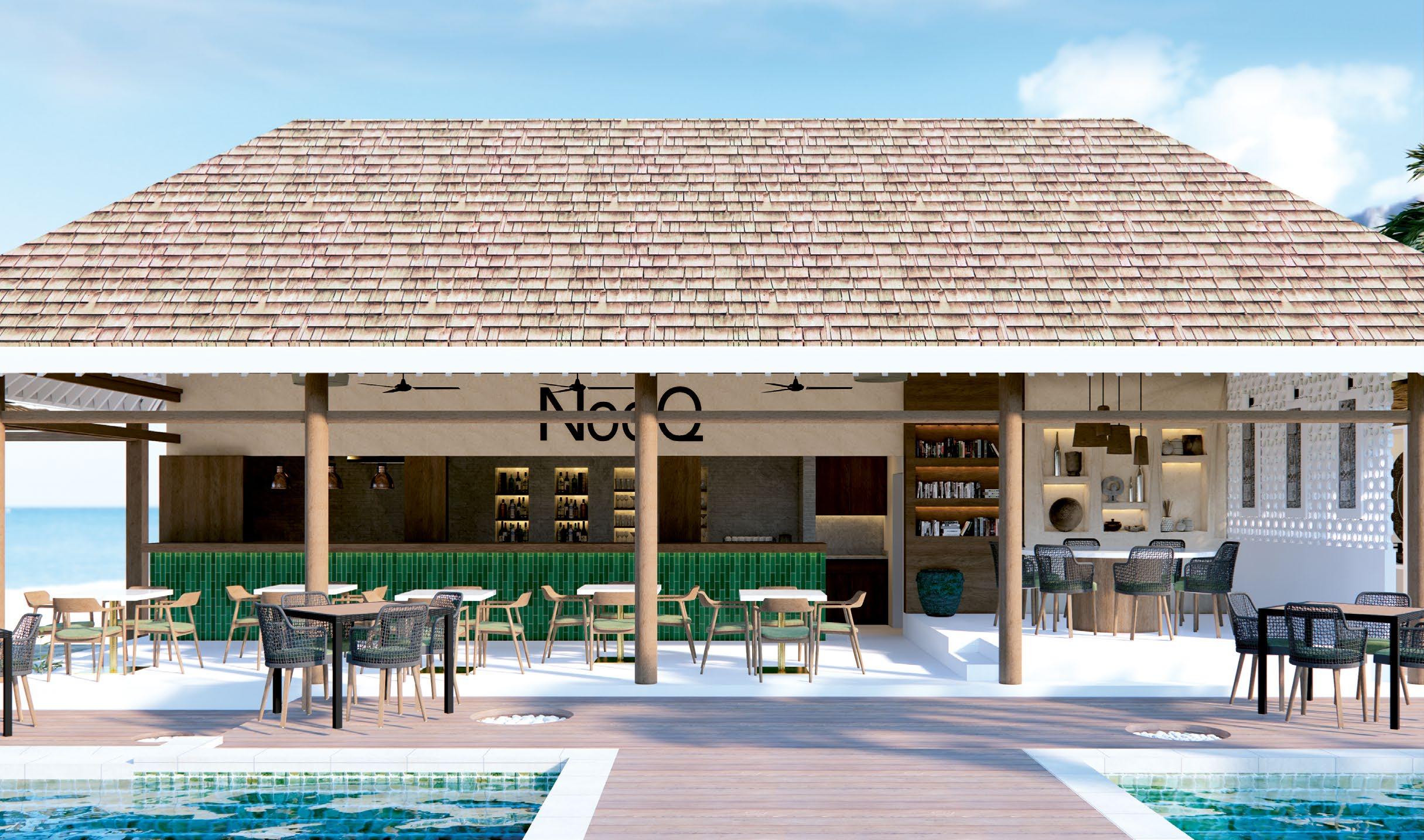










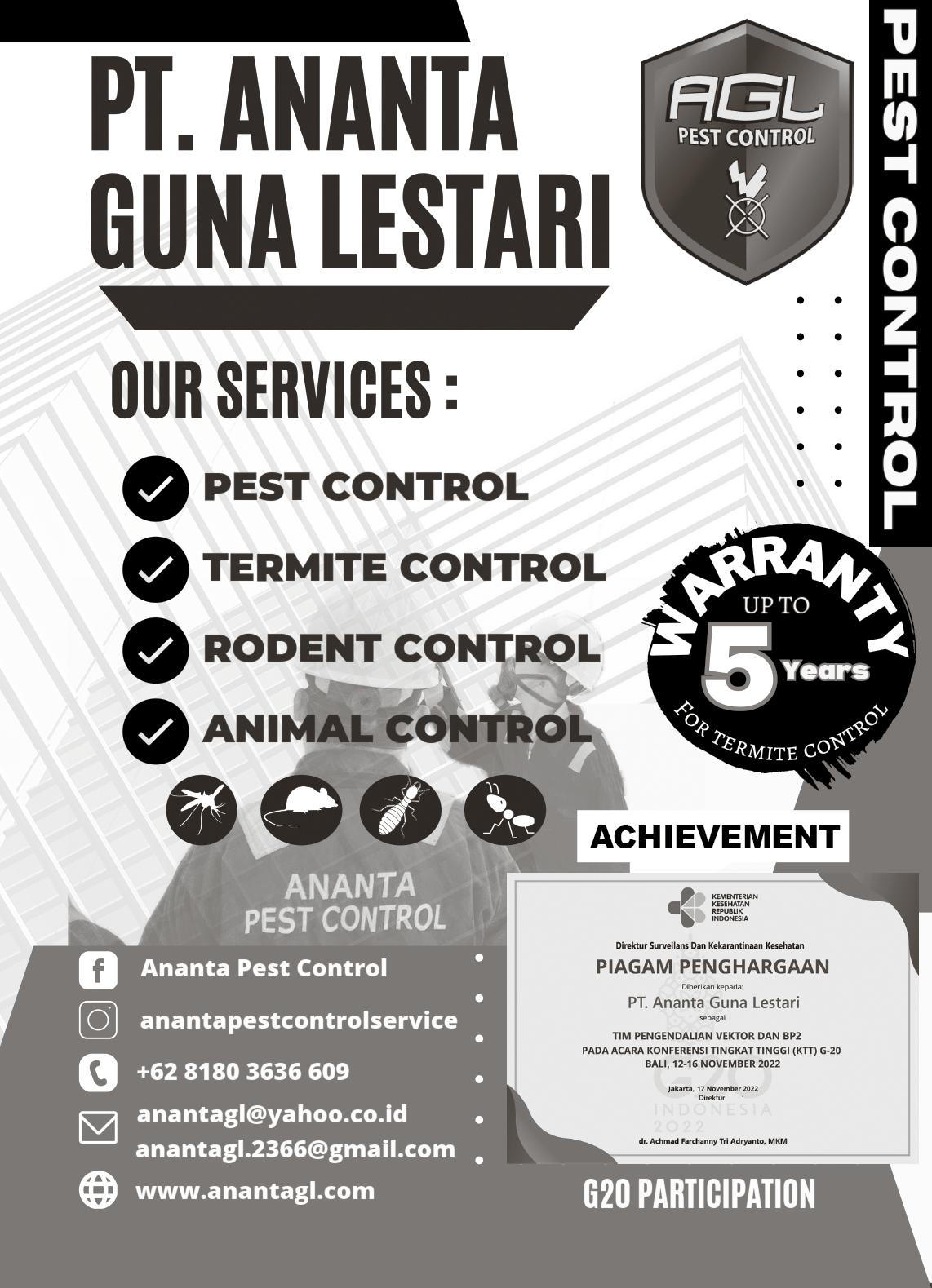



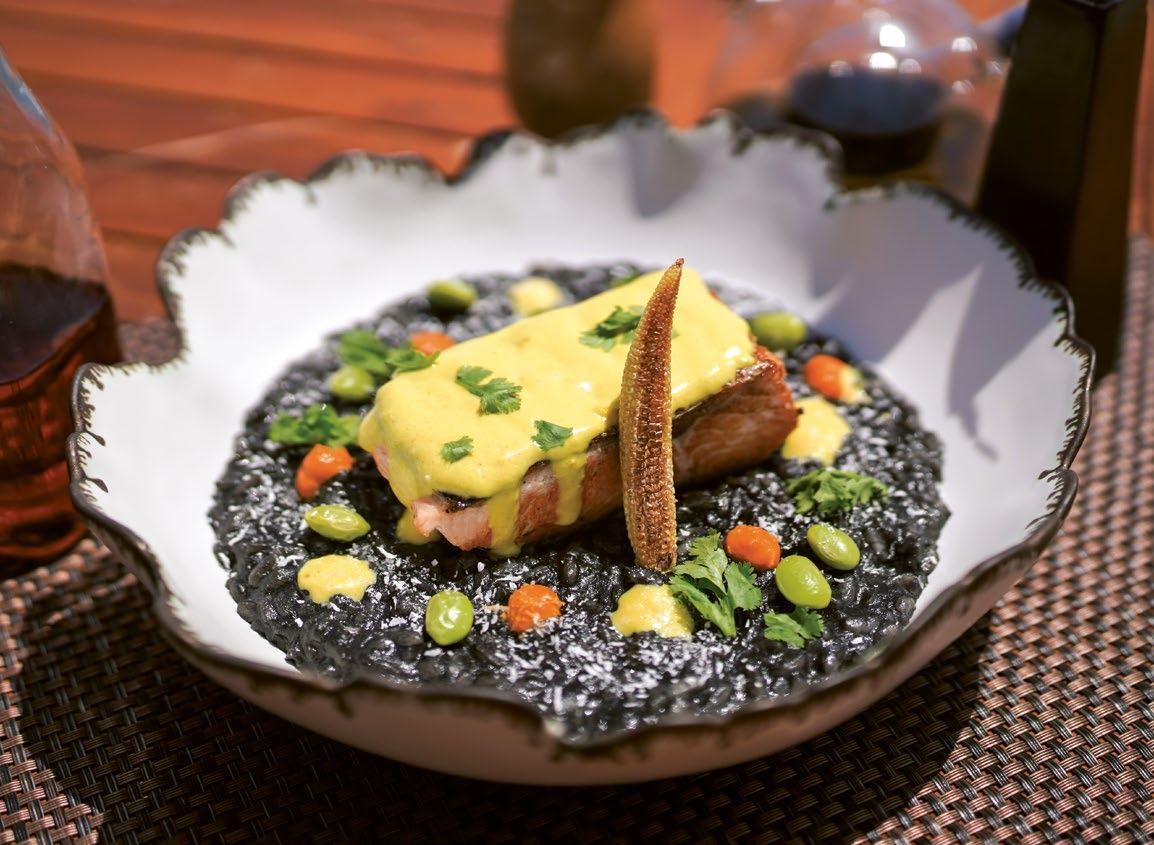







The three main cities in Lombok –Ampenan, Mataram and Cakranegara – have expanded over the years and now merge together to create what is, for Lombok, an urban sprawl of shops, administrative centres and residential areas.
A visit to the cities makes an interesting day trip, exploring the numerous shops selling everything imaginable from everyday items to gold and pearls, and to the Lombok Epicentrum Mall –Lombok’s main shopping mall.
There are many pearl shops in Ampenan and the nearby village of Sekarbela that sell unset pearls and pearl jewellery at attractive prices. These are genuine pearls – some cheap quality from China and more expensive ones farmed in Lombok and Sumbawa. If you bargain the price, you can usually get a good deal.
There are gold shops in both Ampenan and Cakra. The gold sold in Lombok, as with most Asian cities, is 24 karat gold and is sold by the gram at current market price.
For cheap and interesting food choices, explore the many restaurants, warung (local cafés) and food stalls in the cities. Especially in the late afternoon, stalls set up along the main streets selling fresh fish and seafood grilled over hot coals and coated with spicy sauce, satay skewers with spicy peanut sauce, and many other kinds of local street food.
Or just wander around the streets to soak up the atmosphere and discover fascinating insights into Lombok life!
Ampenan was the original port in Lombok during Dutch colonial times and some of the old architecture is still visible around the town, particularly toward the beach to the west, where the remnants of the port are slipping into the sea.

The streets become a market at night, filled with warung and kaki lima (food carts) for cheap, tasty food and local flavour.
Pasar Kebun Roek, just near the traffic lights in Ampenan (near the intersection to Senggigi), is the site of the local markets. Every day traders set up stalls selling fresh produce from around the island, local snacks and products, live chickens and fresh fish in the afternoon when the fishing boats come in. A stroll through the markets is a pungent and enlightening experience!
Mataram, about 3 km to the east of Ampenan, is
the administrative centre for Lombok and Sumbawa (NTB Province), with government offices, banks, mosques, schools and colleges, bookstores, the main post office, and Mataram University downtown.
In Mataram, the Nusa Tenggara Barat (NTB) Museum houses historical and cultural artefacts from Lombok and Sumbawa. It’s an interesting place to visit and occasionally hosts special exhibits. Displays include exhibits on geology, history and culture. Address: Jl Panji Tilar, Taman Sari. The Museaum is open from 8am to 3pm and there is a small admission fee.
Cakranegara (usually abbreviated to “Cakra”) is Lombok’s main shopping area. It is also home to many Chinese and Balinese, who make up over 50 percent of the city’s population. The streets of the city make an interesting walk with gold shops, sporting goods, clothing and fabric stores selling imported silks, laces and cottons, to name a few.
There is a local market at the main intersection in Cakra; turn right at the traffic lights and look for the entrance to the market on the left. Inside is a labyrinth of stalls selling everything from woven baskets to fresh flowers and local food.
The next large town east of Cakra is Sweta. The Bertais Bus Terminal is located here for connections to the east of the island and beyond. Near the bus terminal there is a huge local market every day with all kinds of goods on sale, from foodstuffs to clothing, exotic birds, handicrafts and more.




Lombok Epicentrum Mall on Jl Sriwijaya (see cities map) is Lombok’s most modern shopping centre with four floors of retail outlets. The large, clean and air-conditioned complex houses a Hypermart Supermarket and a Matahari Department Store, as well as a Cinema XXI Movie Theatre.
On the second floor, you’ll find a wonderland for young people and families, with Funtopia and Time Zone entertainment arcades, Play and Learn, Toys City toy shop, and children’s shops.
International brands include UNIQLO, KKV, Adidas, Birkenstock, Puma, Billabong, and more.
There is a well-stocked Ace Hardware store, an Informa furniture store, a Mr DIY discount store, a Sociolla cosmetics outlet and several pharmacies. Other retailers sell a wide variety of fashion including brand name stores, shoes, electronics, sporting goods, and much more.
Food outlets include Burger King, KFC, J. Co, Starbucks, Kimukatsu, Pepper Lunch, Wendy’s and Pizza Hut, as well as many local eateries.
“Epicentrum” as it is known, makes a fun day out if you want some retail therapy and to pick up a bargain. It is also great for families, with entertainment and kids’ activities and a good movie theatre, as well as the fastfood options that they might be missing on holiday.

It’s possible to combine a trip to the cities with a visit to some of the historic sites in the area.
Pura Meru on Jl Selaparang, Cakranegara, was built in 1720 by Balinese Prince Anak Agung Made Karang and is the largest temple on Lombok. Its three meru are for the Hindu trinity – Shiva, Vishnu and Brahma.

This is an important temple for the Balinese here and its annual Pujawali festival, held over five days during the full moon in September or October, is the biggest Balinese Hindu event on Lombok.
The outer courtyard hall has large drums used to announce ceremonies and festivals. In the central courtyard are two buildings with raised offering platforms. The interior enclosure has 33 shrines as well as the three multi-tiered meru.
Entry is Rp 20,000 per person, which includes the loan of a temple sash.
Pura Mayura, just across the street from Pura Meru, was built in 1744 as the court temple of the last Balinese kings in Lombok. An open hall or bale kambang (floating pavilion) stands in the middle of a large artificial lake here and an interesting temple is sheltered under huge old trees at the rear of the lake.
The gardens and the adjoining Pura Jagatnatha temple complex are a peaceful place to escape the bustle of the city and well worth exploring. Do use a guide to get the most out of your visit and understand the interesting history of the park.
Taman Mayura is open every day, from 8am to 8pm; entry is Rp 20,000 per person. The gardens are popular on weekends so the best time to visit is during the weekdays.
Continued from Page 44 Mayura Park Tourism Information

Lombok Police (POLRES NTB): Jl Gajah
Mada 7, Mataram. Emergency No: 110
Emergency Rescue (RSU Mataram)
Ph: 0370 620009 / 0877 7757 7119
HOSPITALS (Rumah Sakit)
Siloam Hospitals Mataram
Jl Majapahit 10 Mataram | Phone: 0370 600
1100 / 0878 8590 8372.
Emergency: 1-500-911
Rumah Sakit Harapan Keluarga
Jl Ahmad Yani 9, Selagalas. Ph: 0370
6177000 / 0813 5353 7941.
Emergency 0859 3096 5695.
Mataram Public Hospital (Rumah Sakit Umum Mataram)
Jl Bung Karno No 3 Pagutan.
Phone: 0370 640774 / 0877 7757 7119
NTB Province Public Hospital (Rumah
Sakit Umum Propinsi)
Jalan Prabu Rangkasari, Dasan Cermen
Phone: 0818 988 119
Central Lombok Public Hospital (Rumah
Sakit Umum Praya)
Jl H Lalu Hasyim, Tiwugalih, Praya.
Phone: 0877 4343 6738
Mandalika Hospital
Jl Kuta-Lombok, Sengkol, Pujut
Phone: 0878 1359 4055
Emergency: 0812 3775 6717.
East Lombok Public Hospital (Rumah
Sakit Umum Dr R Sudjono)
Jl Professor M Yamin No 55, Selong, East Lombok. Phone: 0817 7523 0033
Biomedika Hospital
Jl Bung Karno 143, Mataram. Phone: 0370 645137
Risa Sentra Medika Hospital
Jl Pejanggik 115, Cakranegara.
Phone: 0370 625560 | 632117
DENTISTS (Dokter Gigi)
Drg Farida Istiarini, Sp.Ort (Joli Sourire Dental Care)
1st Floor at Lombok Epicentrum Mall.
Jl Sriwijaya, Mataram. Ph: 0878 6490 1535
Drg Yuanita
Jl Sriwijaya (opposite Kura-Kura Waterpark), Mataram. Ph: 0812 3763 156
Drg. Mumu
Jl Bung Hatta 14, Mataram. Ph: 0853 3730 7008
Drg. Sumi
Mandalika Medicare. Jl Raya Kuta. Ph: 0852 5521 8362
VETS (Dokter Hewan)
Dr Dani (ZZ Pet Care)
Jl. Majapahit No.40, Taman Sari, Ampenan. Ph: 0823 3910 2011
Dr Wahyu (Nobel Petshop)
Jl Sriwijaya (next to Town Palace), Mataram. Ph: 0370 6160300
Dr Hanifah (Humerus Vets)
Jl Majapahit, Next to KD Pet Shop
Ph: 0821 4100 0965
Dr I Gede Sudiana (FB: lombokanimalrescue)
Jl Sadewa 9, Cakra. Ph: 0878 6585 6260
Dr Ajus Ph: 0878 6441 3232
Dr Yoses Kristianto (DC Petshop)
Jl Pabean, Ampenan.
Ph: 0819 99831337
Dr Dwi Ph: 0878 6477 0490
Dr Irfan Ph: 0817 579 0834
Dr Nurul (Kuta) Ph: 0818 0366 2612
TAXI
Blue Bird Taxi: 0370 627000 / 0859 5462 7000
IMMIGRATION
Jl Udayana, Mataram, Ph: 0370 632520
ELECTRICITY
PLN Mataram. Ph: 0370 643123
PLN Ampenan. Ph: 0370 622793
TELKOM (Phone/Internet) Ph: 147
Directory Assistance (Phone Numbers): Ph: 108
CONSULATES
AUSTRALIA
Phone: 0361 2000100. Emergency: +61 26261 3305. Email: Bali.congen@dfat.gov.au
BELGIUM
Phone: 0343 740274.
Emergency: 021 3162030. Email: stefaan.vancolen@st-group.com
BRAZIL
Phone: 0361 8446530. Emergency: 0821 44440018. Email: renato@bythesea.co.id
BRITAIN
Phone: 021 23565200. Email: john.makin@ fco.gov.uk / ika.larasyati@fco.gov.uk
CHILE
Phone: 021 3199 7201 / 02
Email: yakarta@consulado.gob.cl
CHINA
Phone: 0361 239902.
Email: chinaconsul_dps_id@mfa.gov.cn
DENMARK
Phone: 081 1398 0220 / 021 5761487
Email: bali@umgate.dk
ESTONIA
Emergency: 0811 987111.
Email: bharat@consul-estonia.or.id
FINLAND, SWEDEN & NORWAY
Phone: 0361 282223.
Emergency: 0817 9723658.
Email: finnishconsulatebali@yahoo.com / sweconsul@yahoo.com / norwegianconsulatebali@yahoo.com
FRANCE & TIMOR LESTE
Phone: 0361 9345862. Emergency: 021 23557600. Email: consul@dps.centrin.net.id
GERMANY
Phone: 0361-288535. Emergency: 0812 3913938. Email: sanur@hk-diplo.de
HUNGARY
0361 425924. Emergency: 081 2385 3781 / 082 144 933 506.
Email: hubaliconsul@gmail.com
INDIA
Ph. 0361 259502/3.
Emergency: 081353846936.
Email: cg.bali@mea.gov.in / cons.bali@ mea.gov.in
ITALY
Phone: 0361 701005. Emergency: 081 2390 4471. Email: italconsbali@italconsbali.org
JAPAN
Phone: 0361 227628. Emergency: 0361 227628. Email: denpasar@dp.mofa.go.jp
MEXICO
Phone: 0361 223266, 0361 245828.
Emergency: 0361 288218.
Email: yudhara@astinatravel.com
NEW ZEALAND
Phone: 0361 8446456.
Emergency: 0819 99477552.
Email: indy.honcondibali@gmail.com
POLAND
Phone: 0361 263967 / 081 238 78324.
Emergency: 0811 389449.
Email: iblolec@pacificworld.com
RUSSIA
Emergency: 021 5222912
SLOVAK REPUBLIC
Phone: 0361 9005583.
Emergency: 0811810680.
Email: konsulslowakbali@yahoo.com
SOUTH AFRICA
Ph: 0361 751223.
Emergency: 081510533842.
Email: info@bagus-discovery.com
SPAIN
Phone: 0853 3838 5008.
Emergency: 081 38004 1258.
Email: honorary.cspainbali@gmail.com
SRI LANKA
Phone: 0361 728483.
Email: citrabaliide@yahoo.co.id
SWITZERLAND & AUSTRIA
Phone: 0361 264149 / 021 5256 061.
Helpline: +41 800 247 365
Email: bali@honrep.ch
THAILAND
Phone: 081 238 25542. Emergency: 021 2932 8190. Email: rtcdps@yahoo.com
TUNISIA
Ph: 021 52892328/29.
Email: tunisconsulbali@popodanes.org
THE NETHERLANDS
Phone: 0361 761502.
Email: dutchconsulate@kcbtours.com USA
Ph: 0361 233605 / 021 5083 1000.
Email: CABali@state.gov
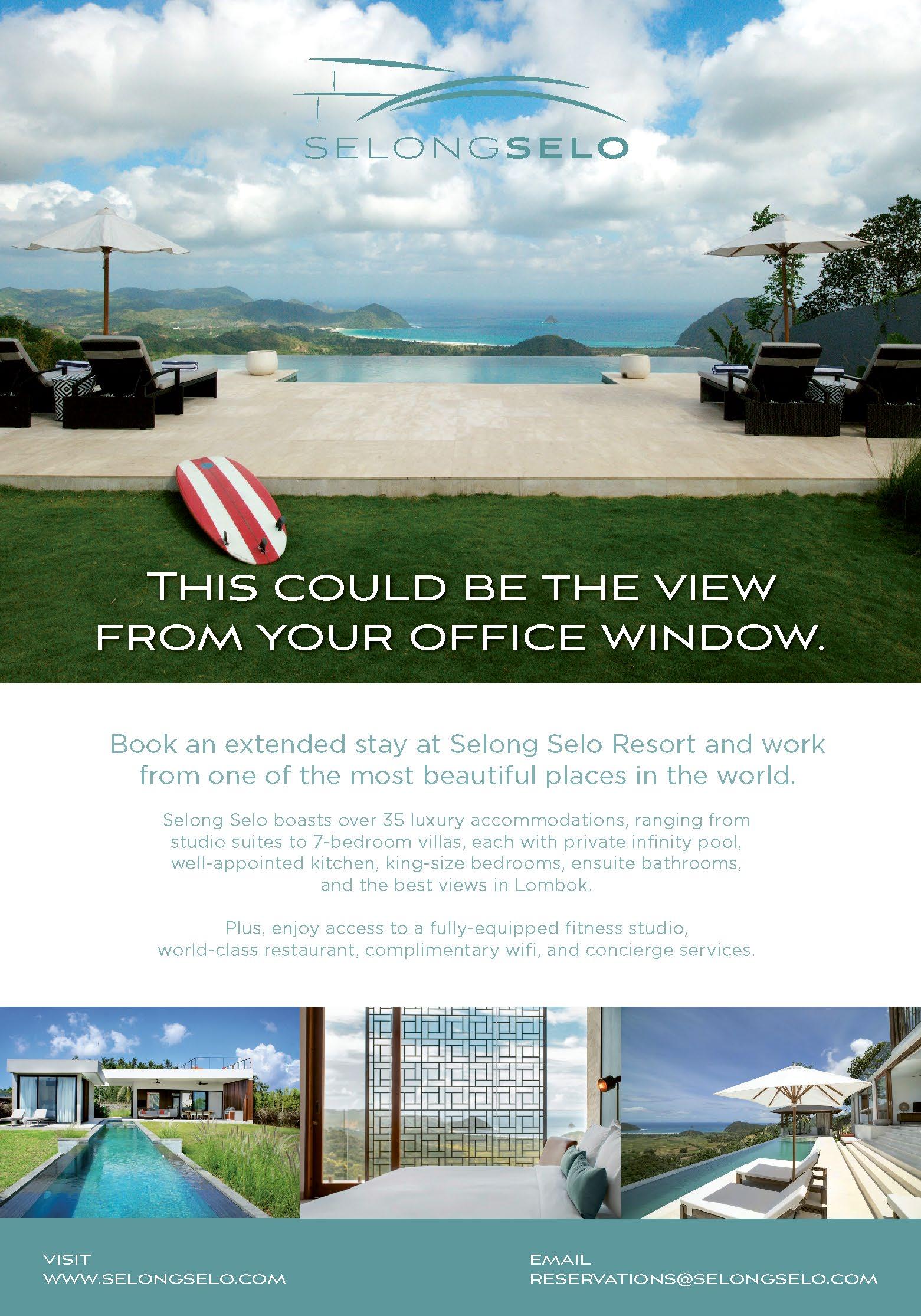

Visitors are drawn to the south for the raw beauty of the southern coastline, stunning beaches and scenery, almost year-round sunshine… as well as some of the best surf breaks in Indonesia!
Located around 60 km south of Mataram, Kuta (sometimes spelt Kute) is the main town and tourism centre on the south coast of Lombok, and is the gateway for exploring the fantastic south coast and the many places of interest in the region.
The Lombok International Airport (LIA) is the only commercial airport on Lombok and is located just 25 minutes’ drive north of Kuta, making access to the south very easy.
The proximity to the airport and the construction of the Mandalika Circuit has sparked an investment boom in the area over the past couple of years and Kuta has transformed into a vibrant town, with many new hotels, restaurants and cafés catering to increasing numbers of visitors.
The Mandalika Circuit – officially called Pertamina Mandalika International Street Circuit – was completed in 2021 and currently hosts World Superbike and MotoGP racing events, drawing thousands to the island during race times.
The Mandalika Resort development, with its plans for luxury hotels, villas and supporting facilities spread over 1000 hectares of prime land, will further transform the south coast in coming years.
Kuta is an area that is rapidly developing – residential areas are spreading, international schools have opened to serve the growing expatriate community, and shopping, services and supporting infrastructure continues to grow.
In the past, Kuta offered mainly low budget hotels catering to the thousands of surfers from around the world who were drawn to the area every year. These days, there is a variety of accommodation to suit all budgets and tastes – from simple hostels and medium range hotels to wonderful boutique resorts and luxurious villas tucked away on the side streets.
At present, Kuta boasts two large resorts: the Novotel Lombok and Pullman Mandalika Lombok Resort. Both are located on the beach just outside of town and offer a range of accommodation from comfortable hotel rooms to spacious suites and villas, some with private swimming pools.
As with accommodation options, new restaurants and eateries have sprung up in the area and are arguably among the best in Lombok. These offer a range of choices – Mediterranean, Seafood, Japanese, Mexican, Chinese, vegan and gluten free, home-made cakes and breads – foodies are truly spoilt for choice!
Kuta offers a full range of tourist facilities from motorbike hire, car rental and tours, surf lessons, surfboard hire and repair. There is a Fresh Market supermarket and various mini-markets, boutiques and shopping, as well as spas, a hair dressing salon, ATM facilities, and more.
Surfing is one of the main reasons to visit Kuta and the town attracts thousands of visitors every year for the great surf locations at Gerupuk, Ekas,
Tanjung Aan, Are Guling and more.
It’s easy to hire a board and a surf guide from here to learn surfing or, for experienced surfers, to access the more challenging surf breaks in the area. There are surf coaches for hire, as well as surf schools and camps throughout the year.
Apart from surfing and days spent hanging out at fabulous beaches, there are many other attractions to explore. The drive between Kuta and the airport reveals interesting rural villages and farming communities where fields of tobacco, corn and peanuts line the roadsides and farmers till the fields using antiquated ploughs pulled by large water buffalo.
Nearby are two traditional Sasak villages – Sade and Rambitan – with authentic clusters of thatched Lumbung, or rice barns, and traditional homes made of thatch and bamboo, with hardened cow and buffalo dung floors.
Both villages have been updated and cater to the tourist market, but there are still interesting examples of traditional Sasak architecture and communal living within the compounds, where life continues as it has for centuries.
Residents, who act as guides for a small fee, encourage walks through either of these villages and are happy to share a glimpse of their lifestyles with visitors.
Also nearby are pottery villages with nice examples of earthenware pots and home décor, and villages that weave traditional fabrics (tenun ikat) using old backstrap looms and techniques passed down through generations.



Otherwise, hire a car or motorbike and you can spend days visiting stunningly beautiful beaches, both to the east and west of Kuta.
Just east of Kuta is Seger Beach (sometimes called Mandalika Beach, after the legendary Princess Mandalika – a beloved character in Sasak folklore who is believed to have sacrificed herself from the rocks overlooking the beach for the good of her people).
It is here that thousands of people gather every year to celebrate the colourful ritual of Bau Nyale, when masses of sea worms spawn in the waters offshore.
There are great views from the beach and even better views if you climb the surrounding hills. There are small stalls selling drinks and snacks to enjoy after taking a swim or a stroll to enjoy the views.
Tanjung Aan, around 5km east of Kuta, is a long picturesque beach with a wide arc of white sand, perfect aquamarine water and shady trees on the shore.
There are a number of warung or beach cafés along the beach selling cold drinks and beer, as well as snacks and simple meals. Many have sun lounges on the beach and guests are welcome to spend
the day swimming in the calm waters and relaxing with a drink or meal.
The water at Tanjung Aan is calm and clear, with a white sandy bottom making it fantastic for swimming. There are also perahu (local outrigger boats) available for hire, offering trips around the bay and to the nearby surf breaks.

There is a small hill (Bukit Antara) towards the east end with steps cut into the side. It’s an easy climb to the top for lovely views and you can watch the surfers catching the waves offshore.
On the far western end of the beach is Bukit Merese – a larger hill and a slightly tougher climb – but worth the effort for the fantastic views from the top. It is popular in the late afternoon, when everyone climbs up to see the spectacular sunsets.
Further east of Tanjung Aan is Gerupuk – well known as a top surf location and situated on a peninsula of land that juts out into the ocean.
The bay is used for fishing and lobster farming and is filled with local boats, which ferry avid surfers to no fewer than five surf breaks nearby. Gerupuk is also evolving
and offers a range of accommodation and cafés to cater to the growing tourist trade. The beaches and wonderful scenery continues all the way to the east coast, with fantastic places such as Bumbang, Awang Bay, Ekas and Pantai Surga (Heaven Beach)… the name says it all!
In the opposite direction, heading west from Kuta, are another series of beautiful beaches and bays hidden behind headlands and rolling hills, providing peaceful and secluded spots for picnics and swimming. All are within easy day trips of Kuta.
Are Guling is popular with surfers, with left and right hand reef breaks as well as a beach break for beginners. There are great views over the bay and to the small island of Gili Nusa off-shore.



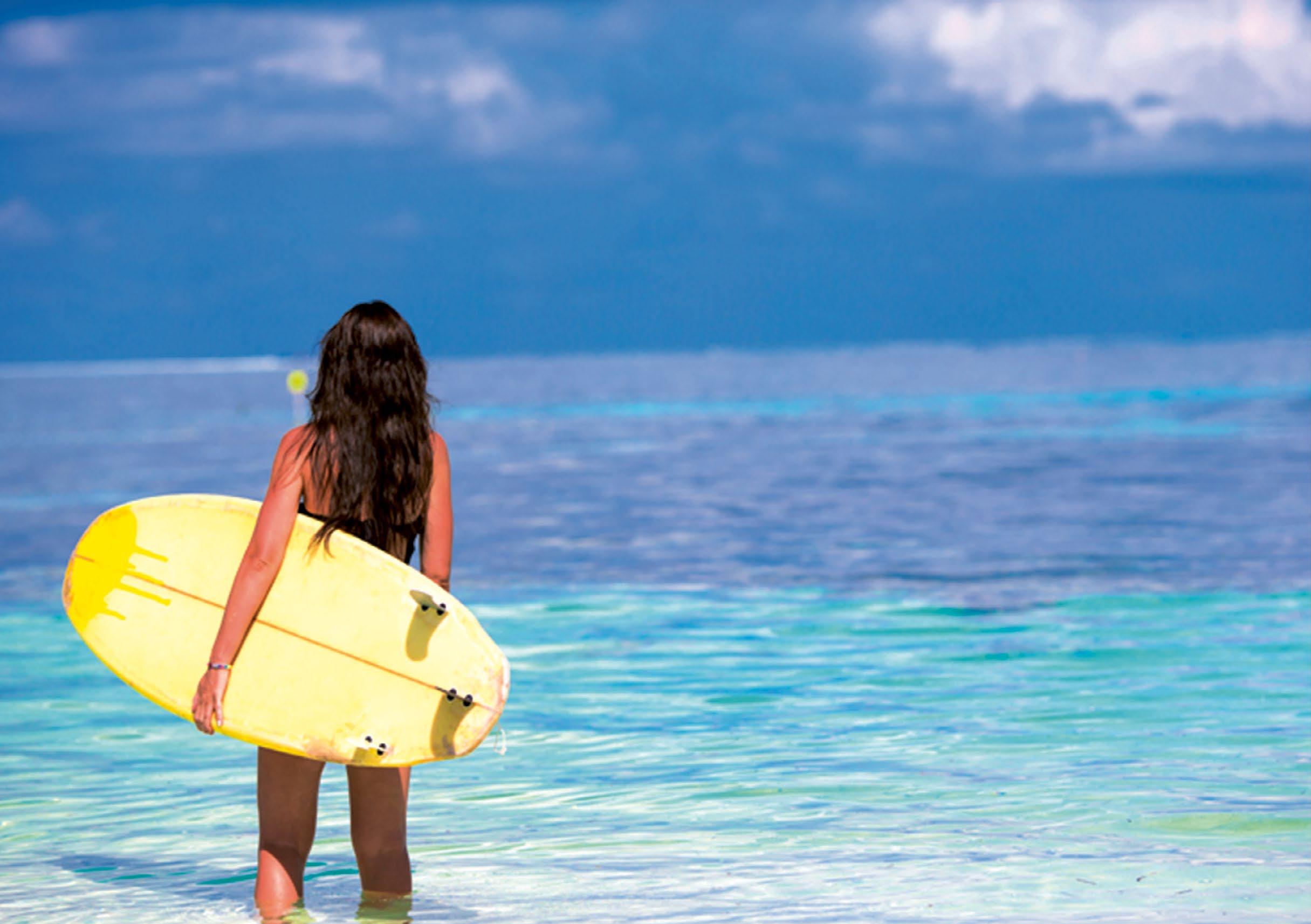






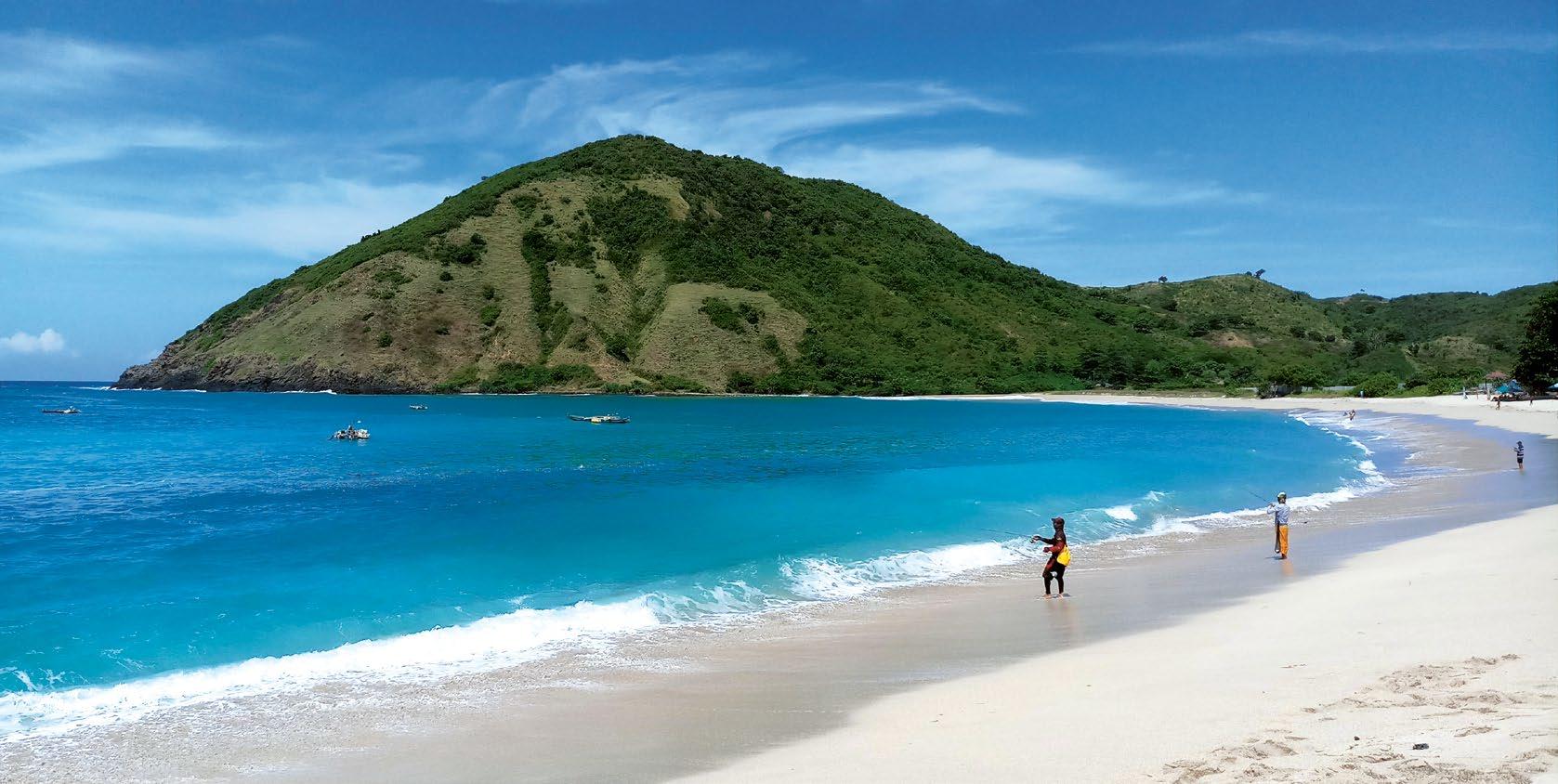
Continued from Page 54
Are Guling has accommodation, mainly catering to surfers, and a number of local cafés, including a couple of places on the beach.
Mawun Beach is around 30 minutes’ drive to the west and is an almost circular bay with small green headlands rolling into the ocean from either side.
It is a spectacular beach with calm blue waters, perfect for swimming and spending a day lazing on the white sand. There are stalls on the beach selling drinks, snacks and simple meals.
Mawi, around another 7km to the west, is for experienced surfers and has good right- and lefthand barrels for surfing when the swell is large enough.
For non-surfers, if you can brave the treacherous road, it is a lovely beach surrounded by small hills, with impressive views; look for the three pinnacles of rock jutting out of the ocean.
Selong Belanak is a long sweeping bay framed on each end by headlands and surrounded by rolling hills. The beach is lovely for swimming and has good waves for body surfing, as well as being popular for beginners surfing lessons.

If you are staying elsewhere, Selong Belanak and the surrounding beaches make a great day trip, with lunch and a swim here as the highlights of your day.
Further west are more beaches to explore – Serangan, Torok, Nambung, Pengantap and more –many of them undergoing some type of development as investors recognize the potential of this gorgeous area.
Further west stils are the picturesque bays of Sepi and Belongas, and many more scenic beaches along the way; all are mostly deserted.
There are many small stalls selling drinks and snacks, as well as offering surf lessons and surf board hire on the beachfront.
Sempiak Seaside Resort has plush villas, some with private pools, perched on the hillside overlooking the bay with breath-taking panoramic views.
Laut Biru Restaurant and Bar at the resort is right on the beachfront with lovely views. It is a popular place for a stop –and justifies a day trip in itself – serving delicious snacks and meals under shady trees on the beach.
Selong Belanak is another area undergoing a lot of growth, mainly due to the popularity of the beach and the wonderful landscapes of the area. Here you will find many small hotels and villas, as well as interesting cafés and shops to explore.

IG: 360surfacademy
www.360surfacademy.com
Steeped in history and legend, surrounded by beaches of almost surreal beauty, the south coast is a fascinating area to visit, whether your interests are historical and cultural, in search of the perfect wave, or just the opportunity to see and explore some of the most beautiful and pristine coastal scenery in Indonesia.



Southwest Lombok boasts long meandering coastlines of pristine white sand beaches and sparkling ocean, with rarely a person to be seen. Off the coast, thirteen small islands - the Southwest Gilis - float in the turquoise waters just waiting to be discovered.
Unlike the famous ‘Gili Islands’ in northwest Lombok, the Southwest Gilis are largely uninhabited and have yet to be discovered by most travellers... that’s why we call them
‘The Secret Gilis’!
The picturesque Southwest region begins from Sekotong, just south of Lembar Harbour, and features stunning beaches and bays set against a backdrop of rolling green hills.
The drive down the southwest coast is an enjoyable trip, meandering through villages where life is largely untouched by tourism and where the people are involved in their day-today activities of farming, fishing, brick-making and other traditional pastimes.
Situated on a wide, placid bay in Sekotong is the peaceful village of Taun (sometimes called Tawun). The sea is sparkling turquoise and the dazzling white sand stretches in a wide sweep around the bay.
Just out in the bay are the three lovely islands of Gili Nanggu, Gili Tangkong and Gili Sudak (and the tiny island of Gili Kedis) – all easily accessible by local outrigger boats. A small sign in the nearby village will direct you to the local boat hire area, where you can arrange boat trips out to Gili Nanggu and the other islands.
Accommodation at Taun has grown over the past few years and there are now small hotels, villas and home stays overlooking the bay. It’s easy to base yourself on the mainland and take boat trips to explore all the southwest islands from here.
Gili Nanggu has accommodation for visitors, with simple cottages on the beach and a restaurant. The island is small and the beach has soft white sand and a good reef just offshore for snorkelling.
Island-hopping tours usually stop at Gili Nanggu, Sudak and Kedis, which all have good snorkelling from the shore.
Back on the main road and travelling a little further south, before the marine culture complex (Balai Budaya Laut), there is a small dirt road leading out onto a white peninsular of sand that juts into beautiful clear waters. Drive to the end for superb views and a close up look at Gili Genting.
Gili Genting sits just off the tip of the peninsular and at low tide you can walk across the sandbar and explore this uninhabited island. Old volcanic rocks and stone carved from centuries of tidal flow create small caves and alcoves, providing shelter for picnics and interesting nooks and crannies to explore.
Further south is the village of Tembowong. There are a few cafés and places to eat here. Nearby is a parking area and a small jetty – the site for catching boats out to Gili Gede, only a few minutes across the water.
Gili Gede: The largest of the islands in the area is Gili Gede, appropriately meaning ‘Big Island’ in the local language. The island lays just offshore and is so large visitors often mistake it for part of the mainland.

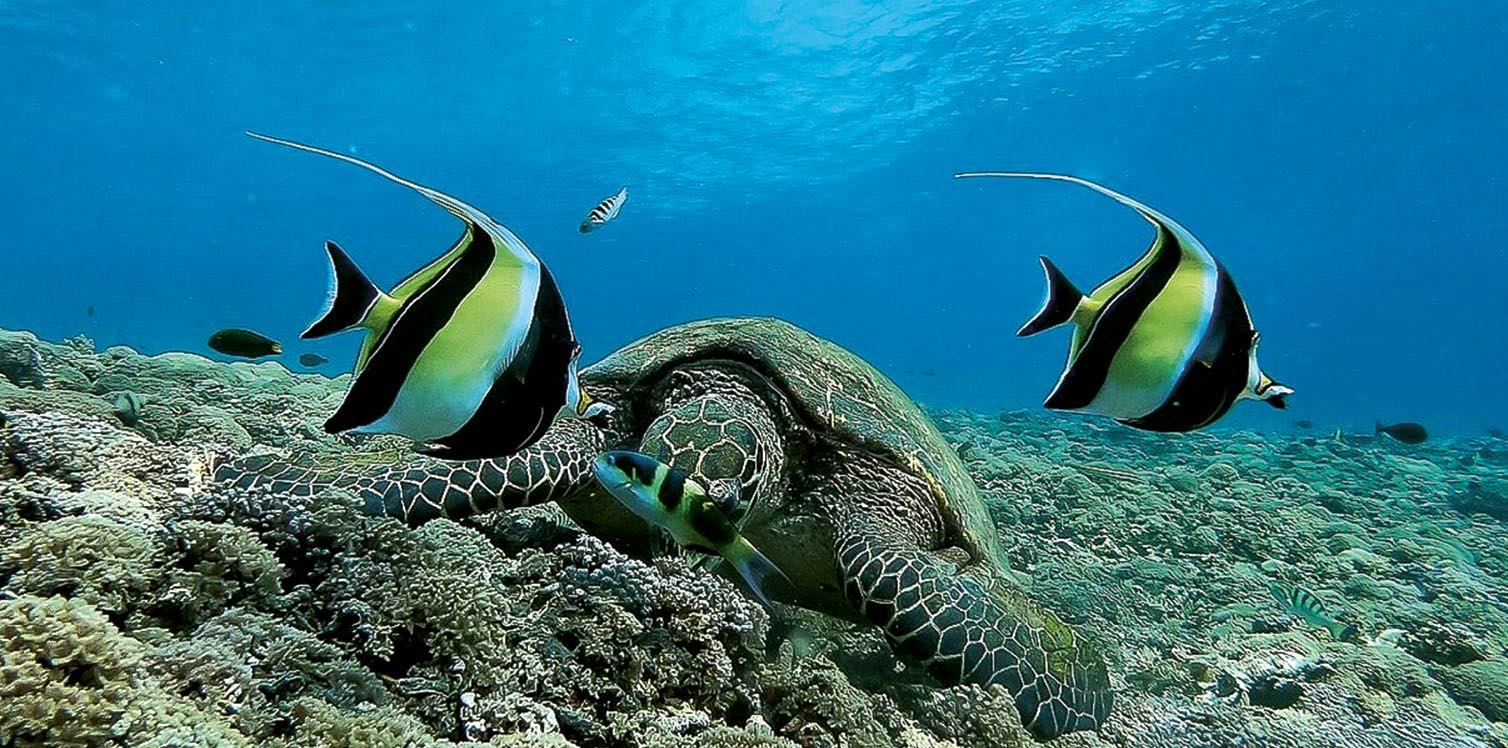
Continued from Page 57
Gili Gede is developing as the main hub for the Southwest Gilis, as it is one of the few islands in the area that has a choice of accommodation, making it an ideal base for exploring the other nearby islands.
Ko - ko - mo Gili Gede Resort is the sister resort to the renowned ko - ko - mo Resort on Gili Trawangan. The luxurious resort, comprising 1- and 2-bedroom villas with private swimming pools, and one bedroom Villa Kecil (small villas), is spread out over spacious grounds on a pristine beachfront. All modern comforts such as air conditioning and ceiling fans, flat screen televisions with satellite channels and DVD, Wi-Fi, fresh (not salt) hot water, plentiful power points for charging devices, and more are provided in each villa.
Facilities at the resort include a tennis court, a small gym, a resort swimming pool and purpose-built Spa facility, and a beachfront restaurant.
Guests at the restaurant can enjoy upmarket dining with a menu prepared from fresh locally-sourced seafood, imported Australian meats and in-house breads and bakery items. There is also an outstanding wine and drinks list.
Ko - ko - mo has a purpose-built jetty at the front of the resort and operate their own fast boat service – ‘Gili Getaway’ – making Gili Gede easily accessible from Bali.
Perched on the hilltop just to the north of ko - ko - mo is Villa Selalu, a private luxury retreat that enjoys outstanding 360º views of the stunning surroundings.

The fully serviced 4-bedroom villa boasts unparalleled luxury with all mod cons and ultra-chic furnishings. Guests can enjoy a number of indoor and outdoor living areas, as well as an 18m infinity pool overlooking the ocean surrounded by a spacious deck, BBQ area and lounging pavilion.
Villa Selalu has a private beachfront and a boathouse equipped with snorkelling gear, sea kayaks, paddle boards and bikes to make the most of your holiday.
Individual rooms are available or rent the villa in entirety for the ultimate island escape!
The High Dive Resort, Gili Gede is the only PADI 5-star certified dive resort in Southwest Lombok and is the perfect choice for those wishing to learn to dive in a small, personalised setting with highly experienced dive masters and instructors.
Whether you are learning to dive, upgrading skills, or just wish to explore an area with pristine reefs, a vast variety of underwater life, and uncrowded diving locations – the High Dive Resort is for you.
The luxurious beachfront bungalows at the resort all feature ocean views and boast king-sized beds, air conditioning, modern bathrooms and a spacious private deck overlooking the beach. There is also a comfortable two-bedroom apartment for families and larger groups.
Continued on Page 62







The restaurant and bar are located on the beach, serving delicious local and international cuisine, with refined vegetarian options and full bar service available. Dining here is a true castaway experience with bare feet in the sand and enchanting views across the water to the nearby islands.
Other accommodation options on the island include some lovely mid-range resorts as well as cottages and home stays with simple accommodation for budget travellers.
Marina Del Ray, on the south of the island, is an Australian-operated yacht marina with a long jetty extending into deep, protected waters offering safe anchorage year-round for visiting boats.
The marina offers customs, immigration, and port control facilities as well as fuel supplies, moorings, provisioning, and repairs. There is also a Yacht Club, with restaurant and accommodation available.
Gili Gede is large enough to provide a range of activities such as hiking to the hills in the centre for fantastic views across the other islands, exploring deserted beaches and hidden coves, and meeting the people living on the island, who are very friendly and, as yet, unspoilt by tourism.
To the south of Gili Gede, the islands of Gili Ringgit, Layar and Asahan are lined up like secret treasures in the calm sea.
Bounty Cruises, a Bali-based company, own a large parcel of land on Gili Ringgit and constructed a pier on the island some years ago. There is good snorkelling on the west side of Gili Ringgit, accessed by boat.
Large gardens of hard and soft corals lay just beneath the surface and the reef extends along most of the island’s coast. On the other side of the island is where the pier is located, is a fantastic white sand beach. It’s easy to snorkel offshore, just north of the pier and, although the reef isn’t as large as on the other side of the island, there is still plenty to see.
Visitors are astounded by the pristine conditions and huge schools of turtles seen
near Gili Layar – the island between Gili Ringgit and Gili Asahan. Bright blue starfish drape themselves across patches of coral, and bright yellow and black Moorish Idols dart through the water. Schools of hundreds of small iridescent fish swim past and weirdlyshaped squid drift by in the deeper areas. There is simple accommodation on Gili Layar and a restaurant serving fresh juices, beers and tasty meals.
Slightly further south, beautiful Gili Asahan attracts visitors with its deserted white sand beaches, clear calm waters and swaying palm trees. There is very good snorkelling just off-shore.
Gili Asahan Eco Lodge and Pearl Beach Resort both offer comfortable accommodation options on the island, and a number of other places offer a range of accommodation to suit all budgets.
Leaving Gili Asahan and back on the mainland, continue south on the coastal road until you come to a main intersection.
A signpost to the left leads to the spectacular large bay at Mekaki. The road to the right leads to Labuhan Poh and Pelangan.
There are small home-stays and private accommodations spaced out along the road to Bangko-Bangko – known as Desert Point and the surfing Mecca for those in the know – located on the far southwest tip of Lombok.
The wide white sand bay is lined with fisherman’s huts and draws hundreds of surfers every year from as far away as Hawaii and Brazil to challenge the huge
waves of Desert Point, just offshore.
Although the road deteriorates after Labuhan Poh, it is still passable for most vehicles in the dry season. During the surfing season, from mid-May to September and again in December, the beach is buzzing with surfers, but otherwise it is a remote and peaceful area. Bali is clearly visible, with the island of Nusa Penida only about an hour’s sail away.
The drive to the point is dotted with bucolic scenery and tiny villages, making it a worthwhile trip even for non-surfers. There is basic surfer accommodation in the area and plans for development in the near future.
The dive sites of the Southwest reflect a good cross-section of what Indonesian diving has to offer. Dive in and be fascinated by turtles, white tip reef sharks, cuttlefish, moray eels and many other varieties of marine life.
The reefs are full of colourful corals, which harbour an amazing variety of marine life, including ghost pipe fish, leaf fish, pygmy seahorses and much more.
For non-divers, the islands are a delight for snorkelling – abundant coral reefs lay just below the surface waiting to be explored, filled with thousands of brightly coloured tropical fish, huge sprawling blue starfish and magical turtles gently gliding through the water.
It’s easy to imagine hotels and resorts on all these beaches and islands in the future but for now, the Southwest is unspoilt and the Gilis remain the secret islands… stunningly beautiful, pristine and unique, and visited only by the lucky few.
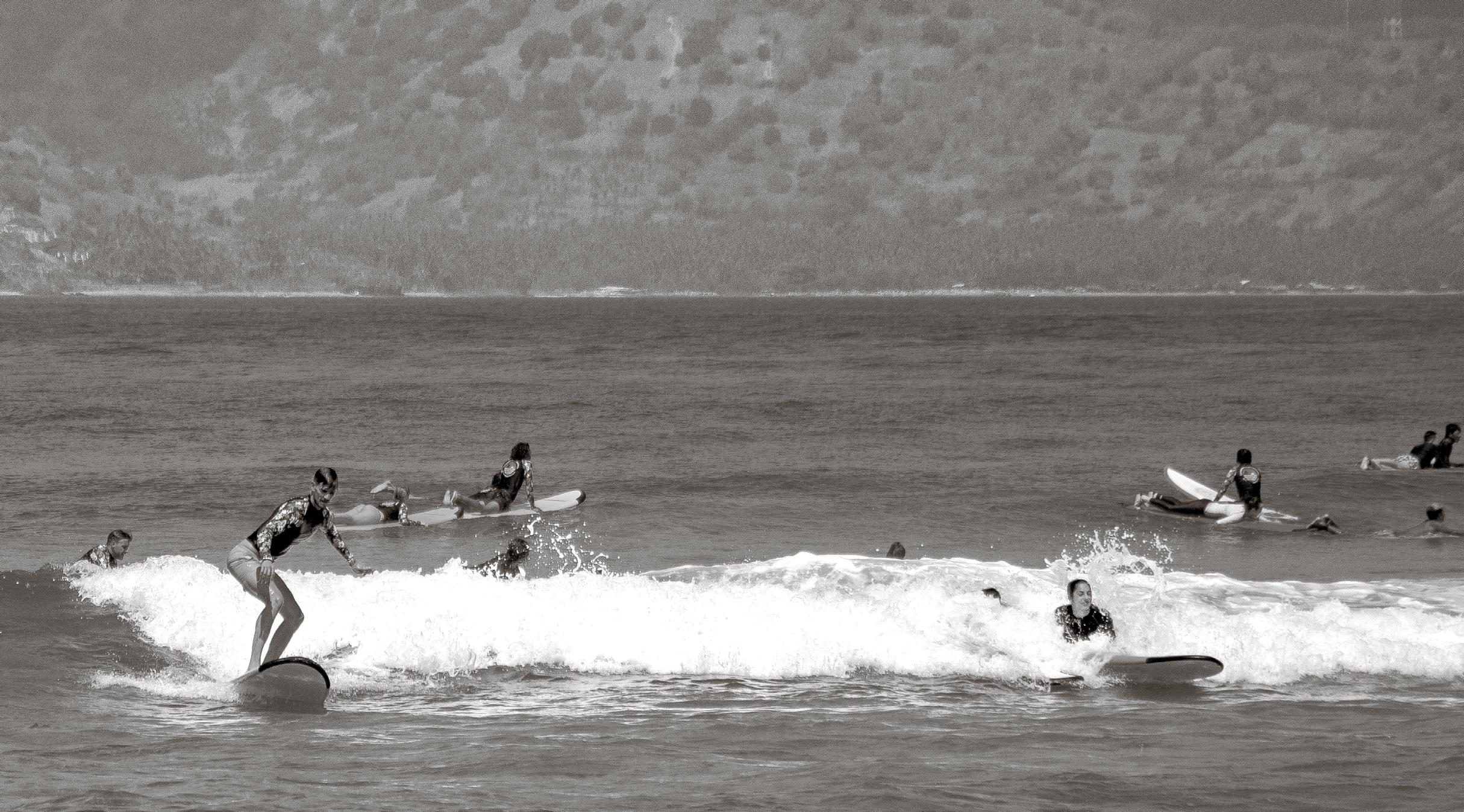
Gili Getaway Fast Boat Service: Gili Getaway operates a convenient fast boat service between Bali and Gili Gede three times a week.
Gili Getaway is fast, comfortable and equipped with safety features to ensure guests’ comfort when travelling between the islands, and is the best option for easy and quick access to Gili Gede and the Southwest Gilis. www.giligetaway.com

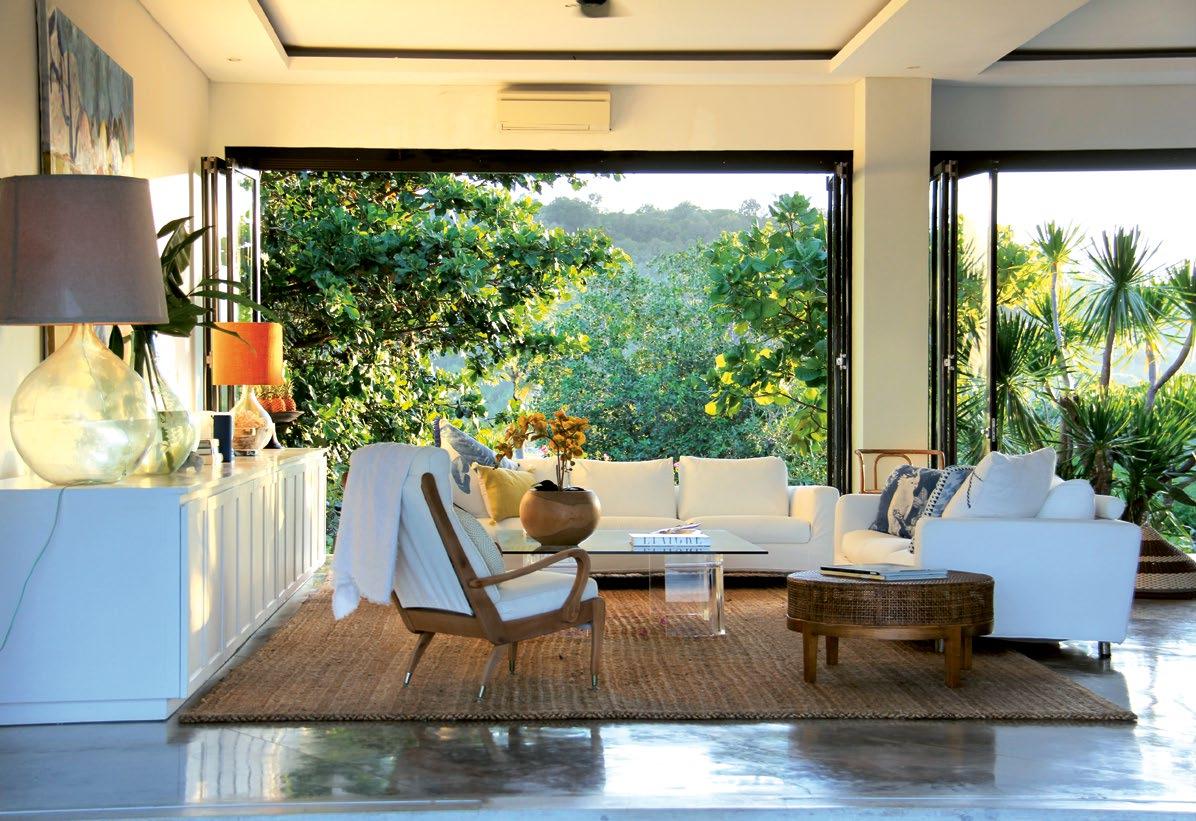

Villa Selalu is a private luxury hilltop retreat on beautiful Gili Gede that enjoys 360-degree, uninterrupted views of a truly unique and untouched part of the world. The villa offers four king-size bedrooms each with marble ensuites and can comfortably accommodate up to 12 guests.
Whether booking one bedroom as a couple, or two or more bedrooms as a group, enjoy the villa exclusively for your stay.
. private jetty .18m infinity pool . private white sand beach . hilltop bbq pavilion . entertainment room . WIFI . commercial kitchen . spacious open plan living . fully air conditioned . tv’s in bedrooms . ceiling fans throughout . hilltop breakfast pavilion . fully catered . dedicated manager and staff. bespoke furnishings & amenities . beach lounges . beach café & bar . bikes . snorkelling gear . kayaks and stand-up paddleboards
ENQUIRIES
www.villaselalugiligede.com